



The Stem Duchies (Stammesherzogtümer) of Germany were essentially the domains of the old German tribes of the area. These tribes were originally the Franks, the Saxons, the Alemanni, the Burgundians, the Thuringians, and the Rugians. In the 5th century the Burgundians moved into Roman territory and were settled in 443 and 458 in the area that would then become Burgundy. The area they had occupied in Germany, next to the Franks and the Saxons, was occupied by the Franks.  When the Rugians were destroyed by Odoacer in 487, a new confederation of Germans formed in their place, the Bavarians.
When the Rugians were destroyed by Odoacer in 487, a new confederation of Germans formed in their place, the Bavarians.
All these tribes in Germany were eventually subjugated by the Franks: the Alemanni in 496 and 505, the Thuringians in 531, the Bavarians at some point after 553, and then finally the Saxons, in a protracted campaign by Charlemagne himself, by 804. When Germany eventually separated as East Francia, the old tribal areas assumed new identities as the subdivisions of the realm, joining Lorraine (properly Francia Media). For the rulers of these, the old Roman title of Dux ("leader") was adopted. It was originally used for a Roman frontier military commander and subsequently was passed down in Greek, i.e. in Mediaeval Romania, as δούξ.
In German, however, the corresponding title, Herzog, looks more like a "calque," a borrowing by translation, of a Greek title, stratêlatês, στρατηλάτης, "army" (stratos) "leader" (elaunein, "to lead"). Thus, the Old High German title was herizoho, from heri, "army," and ziohan, "to lead." This also looks very much like a comparable title, voivode, perhaps also a calque, in Slavic languages. This would seem to reflect the contemporary influence of Romania, rather than some continuity or influence from previous local Roman practice.
On analogy with the German tribes, "duke" was at first used elsewhere for ethnic demi-states, like Brittany and Gascony, and then later as the title for Royal brothers in France, such as the Dukes of Burgundy, and England, beginning with the sons of Edward III -- with the Dukes of Lancaster and York disputing the Throne in the Wars of the Roses. "Duke" as a serious title of independent rule continued mainly in Germany. The Saxon area became Saxony, the Bavarian, Bavaria, the Thuringian, Thuringia, the Frankish, Franconia, and the Alemannian, Swabia. To these could be added the Czech domain of Bohemia, which accepted German suzerainty as a Duchy (one of the ethnic demi-states) by 925, later upgraded to a Kingdom in 1158.
North and South of Bohemia, the Germans headed east, founding a series of March Counties, or Marches, whose ruler was thus a Margrave (Mark Graf). In the North these started with Meißen and Lusatia. North of them was, appropriately, the North March, which became Brandenburg and then Prussia. Last in the north was originally the March of the Billungers, which eventually became the Duchies of Holstein, Lauenburg, Mecklenburg, and (Hither) Pomerania. In the south, there was Carniola, Carinthia, Styria, and the East March, the Österreich ("eastern kingdom"), or Austria. The future dominant states of Germany, Prussia and Austria, thus began as Marches. On the map shown, the eastern frontier is that of about 1200, which is curiously similar to the boundary today between Germany and Poland. At the time, Poland was already an organized and Christian Kingdom. German advance beyond that point was mainly by the extension of Pomerania, originally effected by Denmark, and by Bohemia's detachment of Silesia from Poland. Silesia then passed, with Bohemia, ultimately to Austria, then to Prussia, finally returned to Poland by Josef Stalin in 1945 -- although it turns out this was suggested by Winston Churchill, to compensate the Poles for the territories retained in the East by Stalin.
The greatest houses of German Emperors were associated with particular Duchies: the Saxons, the Franconians (Salians), and the Swabians (Hohenstaufen).
Of the original Stem Duchies, only Bavaria really survived largely intact, though the others sometimes had successor states that nearly reassembled the original domains, like Baden and Württemberg in Swabia and Hanover in Saxony.
These lists originally were often compiled exclusively from Brian Tompsett's Royal and Noble Genealogy and Bruce R. Gordon's Regnal Chronologies. Much of this has now been corrected and expanded, however, with information from Michael F. Feldkamp's Regentenlisten und Stammtafeln zur Geschischte Europas [Philipp Reclam, Stuttgart, 2002] and, most especially, from Andreas Thiele's Erzählende genealogische Stammtafeln zur europäischen Geschichte, Volume I, Parts 1 & 2, Deutsche Kaiser-, Königs-, Herzogs- und Grafenhäuser I & II [Third Edition, R. G. Fischer Verlag, 1997], Volume II, Parts 1 & 2, Europäiche Kaiser-, Königs- und Fürstenhäuser I Westeuropa & II Nord-, Ost- und Südeuropa [Part 1, Third Edition, 2001, Part 2, Second Edition, R. G. Fischer Verlag, 1997], and Volume III, Europäiche Kaiser-, Königs- und Fürstenhäuser, Ergänzungsband [Second Edition, R. G. Fischer Verlag, 2001]. Other sources are listed with the tables or elsewhere. The map above is based on p.142 of The Anchor Atlas of World History, Volume I (Hermann Kinder, Werner Hilgemann, Ernest A. Menze, and Harald and Ruth Bukor, 1974). The cited map is labeled, "Central Europe at the time of the Saxon emperors," which is a little confusing, since the northern frontier is much advanced beyond what was achieved for the dates given, e.g. 937-982. The text simply says, "936-7 Organization of the marches under HERMANN BILLUNG and the margrave GERO..." (p.143). Gero was the Margrave of the North March (later Brandenburg). The area to the north may have been assigned to Billung himself, since the map labels it the "March of the Billungers," but they apparently made little headway at the time, and the name did not stick.
| Dukes of Franconia | |
|---|---|
| Bogo | Count |
| Eberhard I | |
| Udo | 861-879 |
| Eberhard II | d.901 |
| Conrad I | c.906-911 |
| King, 911-918 | |
| Eberhard III | 911-939 |
| Conrad the Younger | 1024-1030 |
| Conrad VI, II of Germany | 1024-1039 |
 Emperor, Emperor,1024-1039 | |
| Henry, III of Germany | 1039-1056 |
 Emperor, Emperor,1039-1056 | |
| Henry, IV of Germany | 1056-1076 |
 Emperor, Emperor,1056-1106 | |
| Conrad VII, II of Lorraine | 1076-1088 |
| Lorraine, 1076-1087 | |
| Frederick I of Swabia | 1079-1105 |
| Conrad I, III of Germany | 1105-1138 |
| Emperor, 1138-1152 | |
| Henry | 1138-1150 |
| Frederick II | 1150-1167 |
| Conrad II | 1167-1196 |
The Fraconian Emperors are often called the "Salians," after the Salian (or Salic) Franks, the sub-group of the Franks that became dominant. This term also turns up in the "Salic Law," the principle that succession cannot pass through women, which was observed in Germany and France but mostly not elsewhere. The Salian Franks, however, were called that because they lived near the sea (salus = "salt"). The inland Franks belonged to several other groups, which collectively could be called the "Ripuarians," i.e. "river" Franks. Franconia was really a Ripuarian, not a Salian, area.
Franconia split into countless states, like Hesse and Nassau. Frankfurt was a Free City until annexed by Prussia in 1866.
| Counts, Dukes, & Princes of Nassau | |||
|---|---|---|---|
| Walram I | 1st Count of Nassau, 1151-1198 | ||
| Henry II the Rich | 1198-1247 d.c.1251 | ||
| Walram II | 1247-1255 | Otto I | 1247-1255 |
| Count of Nassau- Weilburg, 1255-1277 | Count of Nassau- Dillenburg, 1255-1290 | ||
| Adolph I | 1277-1298 | Henry I | 1290-1343 |
| Emperor, 1291-1298 | Nassau- Siegen 1303-1343 | ||
| Rupert IV | 1298-1304, d.1308 | Nassau-
Dillenburg 1328-1343 | |
| Gerlach I | 1298-1355, d.1361 | Emich I | 1290-1303 |
| Walram III | 1298-1322 | Nassau- Hadamar 1303-1334 | |
| Adolph II | 1344-1355 | John | 1290-1303 |
| Count of Nassau- Wiesbaden- Idstein, 1355-1370 | Nassau- Dillenburg 1303-1328 | ||
| Nassau-Weilburg- Saarbrücken from 1355 | Nassau-Dillenburg | ||
| John I | 1344-1371 | Otto II | 1343-1350 |
| Weilburg 1355-1371 | |||
| Rupert | Sonnenberg 1355-1390 | John I | 1350-1416 |
| Philip I | 1371-1429 | ||
| Nassau-Weilburg from 1442 | Adolph | 1416-1420 | |
| Philip II | 1429-1492 | John II | 1420-1443 |
| Engelbert I | 1420-1442 | ||
| John III | 1420-1429 | ||
| John IV | 1442-1475 | ||
| Henry II | 1442-1451 | ||
| Engelbert II | 1475-1504 | ||
| Louis I | 1492-1523 | John V | 1475-1516 |
| Philip III | 1523-1559 | Nassau-Breda | |
| Henry III | 1516-1538 | ||
| René | 1538-1544 | ||
| Prince of Orange 1530-1544 | |||
| Nassau-Dillenburg | |||
| William the Rich | 1544-1559 | ||
| Nassau- Dillenburg 1516-1559 | |||
| Albert | 1559-1593 | Nassau-Orange | |
| William I the Silent | 1559-1584 | ||
| Netherlands 1568-1584 | |||
| Philip IV | 1559-1602 | Philip William | 1584-1618 |
| Louis II | 1593-1625 | Maurice | Netherlands 1587-1625 |
| William Louis | 1625-1629 | 1618-1625 | |
| Nassau- Saarbrücken 1629-1640 | Frederick Henry | 1625-1647 | |
| John IV | 1625-1629 | William II | 1647-1650 |
| Nassau- Idstein 1629-1668 | William III | Netherlands 1672-1702 | |
| Ernest Casimir | 1625-1655 | England 1689-1702 | |
| Frederick | 1655-1675 | 1650-1674 | |
| John Ernest | Wiesbaden 1675-1719 | Dillenburg & Orange ceded to Nassau-Dietz, 1674 | |
| Frederick William | Weilburg 1675-1684 | Nassau-Dietz | |
| Henry Casimir II | Prince of Nassau- Dietz 1662-1696 | ||
| 1674-1696 | |||
| Charles Augustus | 1719-1753 | Nassau-Orange | |
| John William Friso | Netherlands 1702-1711 | ||
| 1696-1711 | |||
| William IV | 1711-1751 | ||
| Charles Christian | 1753-1788 | William V Batavus | 1751-1806 |
| Frederick William | 1788-1816 | William VI, I of Netherlands | 1806-1813 |
| William | Duke of Nassau 1816-1839 | King, 1813-1843 | |
| Adolph | 1839-1866 | German lands ceded to Nassau-Weilburg, 1815; House of Orange continued in Netherlands | |
| Grand Duke of Luxembourg 1890-1905 | |||
| Nassau annexed by Prussia, 1866 | |||
At the Congress of Vienna, there were still the Duchy of Nassau and the Principalities of Usingen and Nassau-Weilburg. The Orange (Ottonian) branch of the family, which had acquired leadership and then sovereignty in the Netherlands, ceded its German lands to the Walramian line at the Congress. In short order the German lands fell to a single line, with the death of Frederick Augustus, Prince of Usingen and Duke of Nassau. Only the line of Nassau-Weilburg is shown on the Walramian side of the table at left, but some parallel lines, including Usingen, are detailed in the genealogical table below.
The final Duke of Nassau, Adolph, ran afoul of Prussia by picking Austria in the Seven Weeks' War of 1866. Nassau was annexed to Prussia. But then, when Queen Wilhelmina was excluded from the succession to Luxembourg by the Salic Law, the Grand Duchy passed to the dispossessed Duke Adolph. Luxembourg, even with Grand Duchesses, has been in the line of Adolph ever since.
The succession was initially assembled from Bruce R. Gordon's Regnal Chronologies. The genealogy at Brian Tompsett's Royal and Noble genealogy was too incomplete to use -- the line of Nassau could not be traced back from Adolph of Nassau and Luxembourg. The genealogy below has now been assembled from the Erzählende genealogische Stammtafeln zur europäischen Geschichte, Volume I, Part 2, Deutsche Kaiser-, Königs-, Herzogs- und Grafenhäuser II [Andreas Thiele, Third Edition, R. G. Fischer Verlag, 1997]. That contains all of Nassau except for the initial Dutch line of Orange-Nassau. This is covered in Volume II, Part 1, Europäiche Kaiser-, Königs- und Fürstenhäuser I Westeuropa [Andreas Thiele, R. G. Fischer Verlag, Second Edition, 1997]. It should be noted that the initial line of Orange-Nassau ended with William III. His cousins of Nassau-Diez(/Dietz) were already Stadholders of Friesland, and they then inherited the title of Orange and the larger role as candidates for Stadholder of the Netherlands. Here, the genealogy of both Dutch lines is given with the Netherlands.

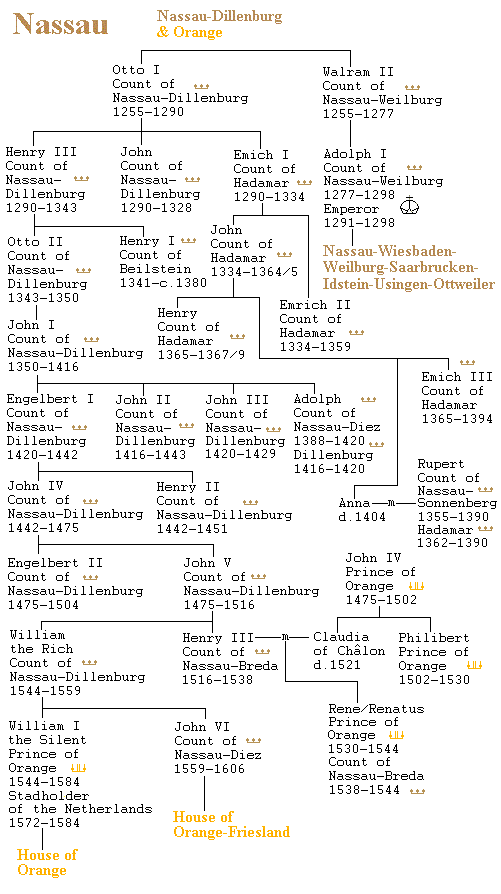 A key event in the history of the Ottonian line is marriage with the heiress, Claudia, of the Principality of Orange. This small state was far from Germany, a fief of Burgundy, surrounded by the Papal enclave of Avignon, whose Princes recently derived from the Free Counts of Burgundy. This did not involve any material addition of power to the House of Nassau, but the title, passing to William the Silent, quickly became symbolic of the Netherlands, which William came to lead in its struggle for independence from Spain. Long after Orange itself fell to France, in 1715, the name, indeed the color, is thought of as essentially Dutch. The subsequent genealogy of Nassau-Orange is found under the Netherlands. The main line of Orange-Nassau died out with William III, but the leadership of the Netherlands then passed to his cousins, who had become the Stadholders of Friesland. In both the Netherlands and Luxembourg, the male lines eventually failed. In the Netherlands the houses of Mecklenburg, Lippe, and Amsberg, and in Luxembourg the house of Bourbon, provided the husbands.
A key event in the history of the Ottonian line is marriage with the heiress, Claudia, of the Principality of Orange. This small state was far from Germany, a fief of Burgundy, surrounded by the Papal enclave of Avignon, whose Princes recently derived from the Free Counts of Burgundy. This did not involve any material addition of power to the House of Nassau, but the title, passing to William the Silent, quickly became symbolic of the Netherlands, which William came to lead in its struggle for independence from Spain. Long after Orange itself fell to France, in 1715, the name, indeed the color, is thought of as essentially Dutch. The subsequent genealogy of Nassau-Orange is found under the Netherlands. The main line of Orange-Nassau died out with William III, but the leadership of the Netherlands then passed to his cousins, who had become the Stadholders of Friesland. In both the Netherlands and Luxembourg, the male lines eventually failed. In the Netherlands the houses of Mecklenburg, Lippe, and Amsberg, and in Luxembourg the house of Bourbon, provided the husbands.
The genealogy here is from the Erzählende genealogische Stammtafeln zur europäischen Geschichte, Volume I, Part 2, Deutsche Kaiser-, Königs-, Herzogs- und Grafenhäuser II [Andreas Thiele, Third Edition, R. G. Fischer Verlag, 1997, pp.376-402].
Landgraves, Electors, & Grand Dukes of Hesse Henry I the Child of Brabant Landgrave,
1263-1298Otto Marburg
1298-1328John Cassel
1298-1311Henry II the Iron 1328-1377 Louis I Grubenstein
1328-1343Herman I Nordeck
1328-1367Herman II the Learned 1377-1413 Louis II the Peaceful 1413-1458 Louis III Cassel
1458-1471Henry III Marburg
1458-1483William I the Elder 1471-1493,
d. 1515William II the Intermediate 1471-1509 William III the Younger 1483-1500 Philip I the Magnanimous 1509-1567, Protestant leader William IV Cassel
1567-1592George I Darmstadt
1567-1597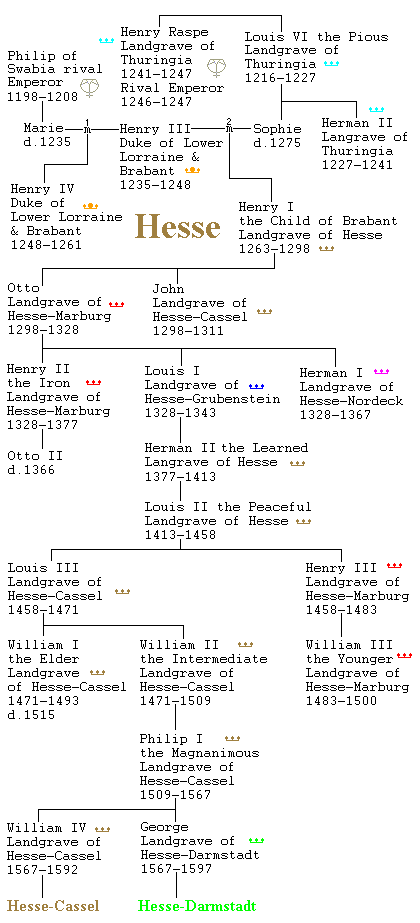 Hesse begins in the middle of interesting marriages. The first marriage of Henry III of Lower Lorraine and Brabant was to Marie of Hohenstauften, daughter of Philip of Swabia and Irene Angelina, daughter of the Emperor Isaac II Angelus. By this marriage the line of the Comneni and Angeli enters much European royalty. But Henry contracted a second marriage. This was to Sophie of Thuringia, daughter of the Landgrave Louis VI. While Henry's son, Henry, from his first marriage succeeded to Brabant, his son from his second marriage, also Henry, was endowed with the Landgravate of Hesse. The domain underwent various divisions and recombinations. Finally, the two sons of Philip the Magnanimous, one of the leaders of the Protestant Reformation, founded two durable divisions, Hesse-Cassel and Hesse-Darmstadt. George, the first of the line of Hesse-Darmstadt, also had a son, Frederick, who founded a third line, Hesse-Homburg. Hesse-Cassel and Hesse-Homburg were annexed by Prussia in 1866, while Hesse-Darmstadt survived, under the German Empire, until the end of World War I.
Hesse begins in the middle of interesting marriages. The first marriage of Henry III of Lower Lorraine and Brabant was to Marie of Hohenstauften, daughter of Philip of Swabia and Irene Angelina, daughter of the Emperor Isaac II Angelus. By this marriage the line of the Comneni and Angeli enters much European royalty. But Henry contracted a second marriage. This was to Sophie of Thuringia, daughter of the Landgrave Louis VI. While Henry's son, Henry, from his first marriage succeeded to Brabant, his son from his second marriage, also Henry, was endowed with the Landgravate of Hesse. The domain underwent various divisions and recombinations. Finally, the two sons of Philip the Magnanimous, one of the leaders of the Protestant Reformation, founded two durable divisions, Hesse-Cassel and Hesse-Darmstadt. George, the first of the line of Hesse-Darmstadt, also had a son, Frederick, who founded a third line, Hesse-Homburg. Hesse-Cassel and Hesse-Homburg were annexed by Prussia in 1866, while Hesse-Darmstadt survived, under the German Empire, until the end of World War I.
| William IV | Cassel 1567-1592 | |
| Maurice the Learned | 1592-1627 | |
| William V | 1627-1637 | |
| William VI | 1637-1663 | |
| William VII | 1663-1670 | |
| Charles | 1670-1730 | |
| Frederick | King of Sweden, 1720-1751 | |
| 1730-1751 | ||
| William VIII | 1751-1785 | |
| William IX, I as Elector | 1785-1803 | |
| Elector, 1803-1807, 1813-1821 | ||
| French occupation, 1807-1813 | ||
|---|---|---|
| William II | 1821-1847 | |
| Frederick William | 1847-1866, d. 1875 | |
| Annexed to Prussia, 1866 | ||
Hesse turns up, curiously, in the history of the American Revolution, since Hessian troups were hired out to King George III and sent to fight against the colonists. George Washington captured many of them at Trenton in 1776.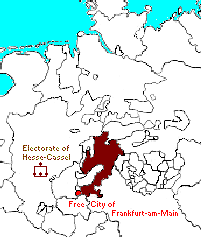
The Landgrave of Hesse-Cassel, William IX (1785-1803), who became William I, the first Elector of Hesse-Cassel (1803-1807, 1813-1821) would be remembered as the patron of the Rothschild Family. Mayer Amschel Rothschild (1744-1812) was a minor merchant in the Jewish Ghetto (on the Judengasse) of the Imperial City of Frankfurt-am-Main (a Free City in 1815), adjacent to Hesse-Cassel. Mayer found coins and other valuables for the Landgrave. A mythology grew up that when William had to flee Napoleon in 1807, he entrusted his movable wealth to Mayer and his sons, who then returned it, with interest, when William returned in 1813, securing the Elector's firm trust and patronage from then on.
This story would later be promoted by the Rothschilds themselves, but it was only partially true. William entrusted his wealth to many. This included Mayer, but not exclusively; and the Rothschild share was not even predominant. Instead, the real source of Rothschild hegemony began when Mayer sent his son Nathan to Britain, by 1800, to get more closely involved with the textile trade and business. This meant that Nathan went to Manchester. Soon, however, both Mayer and Nathan began moving to banking and finance, which meant than Nathan relocated to London. Eventually, the five sons of Mayer spread out across Europe, founding branch banking houses, with Salomon in Vienna, James in Paris, and, curiously, Carl in Naples, while Amschel, the eldest, stayed in Frankfurt after the death of Mayer in 1812. Naples now does not sound like a great financial capital, but in 1821 Carl followed Austrian armies, financed by the Rothschilds, who restored the Bourbons after a local uprising.
That actually reveals a lot about the nature of the Rothschild business. They may have been providing some start-up captial for entrepreneurs, but the major part of their practice was getting money for governments.
  Nolite confidere in principibus. Put not your trust in Princes. |
| Psalms 146:3 Septuagint 145:3, Vulgate 145:2 |
|---|
What we might regard as the relative insignificance of Naples as a banking center is born out by the early demise of the house there, in 1863, shortly after the overthrow of the Bourbon kingdom (1860) and the unification of Italy (1861). A similar fate awaited the original Frankfurt house. While it was a coincidence that the Rothschild's derived from the Frankfurt Ghetto, Frankfurt was for a long time an important place in its own right, holding such a status as would have existed as the capital of the Holy Roman Empire (shared with Regensburg, Casta Regina, where the Imperial Diet sat from 1663, but passing to Bavaria in 1810), where Emperors were elected and, sometimes, installed -- although never residing there.
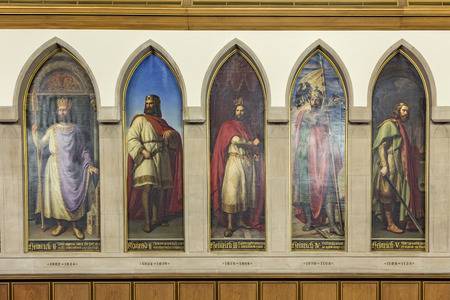 |
|---|
| The Saxon Emperor Henry II, and the Salian Emperors Conrad II, Henry III, Henry IV, & Henry V; The Römer Kaisersaal, Frankurt-am-Main |
The Town Hall (Rathaus) of Frankfurt is called the Römer, i.e. the "Romans" (although this may have just been the family name of the owners of the original building), and it contains the Kaisersaal, or the "Emperors Hall," where an inauguration feast was held for the Emperor Matthias in 1612. The Hall now holds 52 portraits, of all the Holy Roman Emperors from Charlemagne to Francis II, although these only date from the early 19th century, and their quality is uneven. There were also busts, but these were destroyed by Allied bombing in World War II.
James Bryce, in The Holy Roman Empire [1904, Schocken Books, 1961, 1964], gives us a nice anecdote about the paintings:
GOETHE has described the uneasiness with which, in the days of his childhood, the burghers of his native Frankfort [sic] saw the walls of the Roman Hall covered with the portraits of Emperor after Emperor, till space was left for a few, at last for one. In A.D. 1792 Francis the Second mounted the throne of Augustus, and the last place was filled. [p.408]
This makes it sound like the portraits date from the 18th, not just the 19th, century, at least. And we might want to say that the "throne" mounted by the German Emperors was not exactly that of "Augustus" -- more like Charlemagne, at best -- and the portraits include no actual Romans. And Bryce adds in the footnote to this passage:
The Römer Saal is still one of the sights of Frankfort. The portraits, however, which one now sees in it, seem to be all or nearly all of them modern; and few have any merit as works of art. [ibid.]
Depending on what Bryce means by "modern," we might wonder if some of the paintings of Goethe's youth may have been replaced, explaining references that the portraits only date from the early 19th century, rather long after his "childhood."
 With the demise of the Empire, Frankfurt became the formal capital of the German Confederation, and what was intended as a German National Parliament met there in 1848. The failure of German Republicanism, however, also meant the eclipse of the significance of Frankfurt. Once the new German Empire formed around Prussia, and Berlin became the center of govenment and finance, the Frankfurt Rothschild house was distant from the center of German events. It was closed in 1901, leaving Rothschild banks in London, Paris, and Vienna. Curiously, while Frankfurt might have been revived as the Cold War capital of West Germany, the obscure site of Bonn was chosen instead, perhaps to facilitate a move back to Berlin at reunification, which is what happened. Meanwhile, the Kaisersaal continues to host public events, rarely of national significance.
With the demise of the Empire, Frankfurt became the formal capital of the German Confederation, and what was intended as a German National Parliament met there in 1848. The failure of German Republicanism, however, also meant the eclipse of the significance of Frankfurt. Once the new German Empire formed around Prussia, and Berlin became the center of govenment and finance, the Frankfurt Rothschild house was distant from the center of German events. It was closed in 1901, leaving Rothschild banks in London, Paris, and Vienna. Curiously, while Frankfurt might have been revived as the Cold War capital of West Germany, the obscure site of Bonn was chosen instead, perhaps to facilitate a move back to Berlin at reunification, which is what happened. Meanwhile, the Kaisersaal continues to host public events, rarely of national significance.
Nathan's London bank began to become a factor in British politics. His son Lionel was elected to the British Parliament in 1847 but was not seated because he could not take the oath of office as a Christian. It was not until 1858 that the House of Lords agreed that the Commons could decide on its own oath, which was altered so that Lionel could be seated. Benjamin Disraeli, himself a converted Jew, welcomed Lionel as the first Jew to be seated in Parliament --  although others of Jewish ancestry, like Disraeli, had been seated. The determination of the Rothschilds to avoid conversion and to adhere faithfully to Judaism encouraged Jews and embarrassed or angered others, not the least, of course, including anti-Semites, whose activities, particularly in France, Russia, and Germany, became increasingly alarming.
although others of Jewish ancestry, like Disraeli, had been seated. The determination of the Rothschilds to avoid conversion and to adhere faithfully to Judaism encouraged Jews and embarrassed or angered others, not the least, of course, including anti-Semites, whose activities, particularly in France, Russia, and Germany, became increasingly alarming.
A few years later, in 1875, Disraeli was Prime Minister, and the collapse of Egyptian finances led to an offer of all Egypt's shares in the Suez Canal Company to Britain. This famously involved Disraeli soliciting a loan from no less than Lionel Rothschild, for £4 million. Lionel asked what the security or collateral for the loan would be, and Disraeli answered that it would be no more and no less than the full faith and credit of the British Government. That was good enough, although the Liberals complained that such a loan had not been authorized by Parliament. And so we find the Rothschilds, still, providing money to governments -- which in this case led to Britain occupying Egypt in 1882, and becoming the de facto ruler of the country until after World War II -- during which the British fought epic battles with the Germans -- commanded by Erwin Rommel -- out in the desert. The Suez Crisis of 1956 ended British involvement with the Canal.
The diagram below of the genealogy of the Rothschilds is based on the diagram in The House of Rothschild, Money's Prophets, 1798-1848, by Niall Ferguson [Penguin, 1998, 1999, pp.xviii-xxi]. The same diagram occurs in Volume 2 of the history, The House of Rothschild, The World's Banker, 1849-1999 [Penguin, 1998, 2000, pp.xvi-xix]. The diagram here is one of the most tangled of any of the genealogies in the history pages of the Proceedings of the Friesian School. But the diagram does not even have the full detail of Ferguson's. The tangle is largely the result of the intermarriage among about the first three generations of Rothschilds. Mostly this is marriage between cousins, but we also get the marriage of elder brother James to own niece, Betty. This is what got the Hapsburgs into so much genetic trouble, when Philip II of Spain married his niece, Anne of Austria. The Rothschilds seemed to avoid the worst of those consequences, and now exogamy has been the rule for many years.
To try and make the diagram more readable, I have color-coded and numbered the lines of descent from the five sons of Mayer Amschel Rothschild. Numbered "1," in brown, is the eldest son, Amschel, in Frankfurt, who, however, had no children. Numbered "2," in blue, is the lineage of the third son, Nathan, who is given "2" because he founded the first Rothschild House outside Germany, in London. Numbered "3," in red, is the lineage of Salomon, the second son, in Vienna. Numbered "4," in green, is the lineage of Carl, in Naples. And finally, numbered "5," in purple, is the lineage of James, the youngest son, in Paris. The loss of intuitive detail here the most regretable is that it is difficult to see which generation of the family we are looking at in each case. There is a prominance of the blue of the London House because Nathan was pretty much the dominant brother of the Rothschild partnership and because of the continued prominence of the English family, which included material involvement in Jewish Emancipation in Britain (1858) and the elevation of Nathan's grandson to the Peerage (1885). There is now also the marriage of Nathan's great-great-great-great-grandson James, to Nicholai "Nicky" Hilton, with two children. In the diagram, male and female Rothschilds are indicated in the familiar way, with color and number for their lineage. The lineages can be followed with the appropriately colored lines, which, because of the marriages, shoot from one side of the diagram to the other.
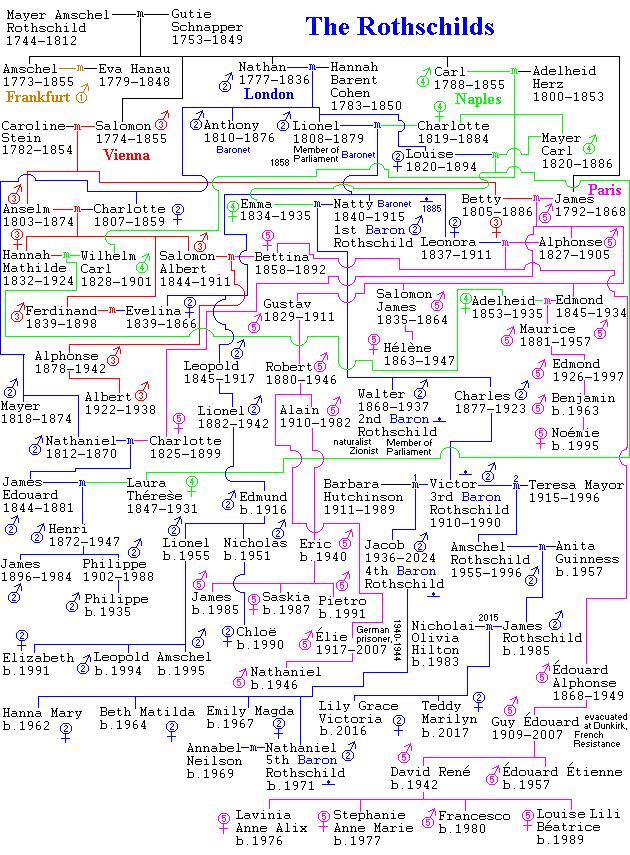
Eventually, not only was there exogamy but also marriages to Christians, not always accompanied by Rothschild conversion. Especially noteworthy is the marriage of Lionel's niece Hannah Rothschild to the Earl of Rosebery, who was briefly Prime Minister of Great Britain (1894-1895) -- unfortunately after Hannah had died. 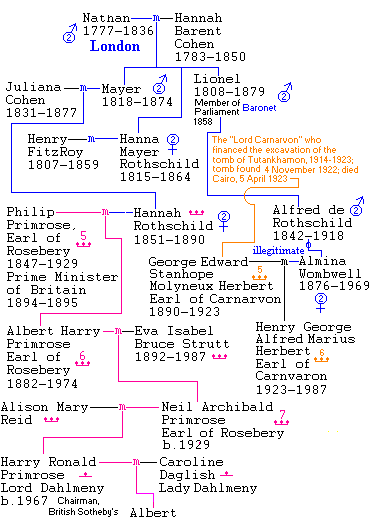 Hannah never converted to Christianity, attended synagogue, observed Jewish holidays, and was buried in a Jewish cemetery -- although her four children, who were born Jewish by virtue of a Jewish mother, were raised Christian. This was Scottish nobility, and the family seat is still near Edinburgh -- Scottish nobility that now continues with Rothschild and, for that matter, Cohen,
Hannah never converted to Christianity, attended synagogue, observed Jewish holidays, and was buried in a Jewish cemetery -- although her four children, who were born Jewish by virtue of a Jewish mother, were raised Christian. This was Scottish nobility, and the family seat is still near Edinburgh -- Scottish nobility that now continues with Rothschild and, for that matter, Cohen,  , ancestry. A long way from the Frankfurt Judengasse.
, ancestry. A long way from the Frankfurt Judengasse.
As we see included in the diagram at right is an earlier marriage of Hannah Mayer, daughter of Nathan, to Henry FitzRoy, a member of the family of the Dukes of Grafton, descendants of Barbara Villars, one of the mistresses of King Charles II of England. Their descendants are untitled.
Of larger significance is Alfred, the second son of Lionel, because Alfred, who never married, had an illegitimate daughter, Almina, who married the 5th Earl of Carnarvon. With a marriage settlement of the staggering sum of £500,000, the Earl was the very man who financed the discovery of the tomb of Tutankhamon. After his death, Almina continued to supervise the dig, until the Egyptian government took over.
Of particular interest in the main genealogy is Walter Rothschild, 2nd Baron Rothschild (1868-1937). At seven years old, Walter was already interested in zoology and professed an ambition to create a zoological museum. Pushed into the family business from 1889 to 1908, and in Parliament from 1899 to 1910, Walter was finally freed to devote all his attention to natural history and collecting. From 1892 he had already opened his house in Tring Park as a museum.
In a delightful stunt, to demonstrate that zebras could be tamed like horses, Walter drove a carriage with a team of four zebras to Buckingham Palace. On his death in 1937, the Tring house was willed to the British Museum and its subsidiary, the Natural History Museum. Some of his collection, however, had been sold in 1932 to the American Museum of Natural History to pay off a blackmailing former mistress.
Walter never married and did have at least one illegitimate child. The title passed to his nephew, Victor. Despite retreating from business and politics, Walter nevertheless remained involved with Zionism.  Thus, an extraordinary footnote to this life is that the original Balfour Declaration, that the British Government would favor a "national home for the Jewish people" in Palestine, was a personal letter written by Arthur Balfour, British Foreign Secretary, to no less than Walter Rothschild, simply mailed to his London residence, in Piccadilly.
Thus, an extraordinary footnote to this life is that the original Balfour Declaration, that the British Government would favor a "national home for the Jewish people" in Palestine, was a personal letter written by Arthur Balfour, British Foreign Secretary, to no less than Walter Rothschild, simply mailed to his London residence, in Piccadilly.
| American Families in Business and Politics | |||
|---|---|---|---|
| The Du Ponts | The Astors | The Vanderbilts | The Johnsons |
| The Rockefellers | The Roosevelts & Delanos | The Hearsts | |
| The Kennedies | The Hiltons | The Fords | The Bushes |
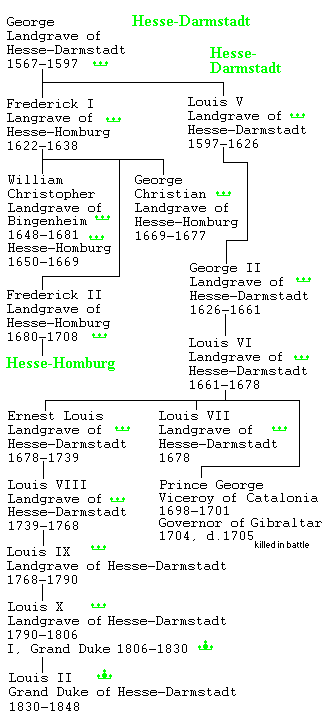 Philosophy of Religion, Judaism
Philosophy of Religion, Judaism
| George I | Darmstadt 1567-1597 |
| Louis V | 1597-1626 |
| George II | 1626-1661 |
| Louis VI | 1661-1678 |
| Louis VII | 1678 |
| Ernest Louis | 1678-1739 |
| Louis VIII | 1739-1768 |
| Louis IX | 1768-1790 |
| Louis X, I as Grand Duke | 1790-1806 |
| Grand Duke, 1806-1830 | |
| Louis II | 1830-1848 |
| Louis III | 1848-1877 |
| Louis IV | 1877-1892 |
| Ernest Louis | 1892-1918 d. 1937 |
Of great interest are the marriages made by Hesse-Darmstadt in its final years. The Royal Houses of Britain and Spain, as well as the House of Russia, if all the children of Nicholas II had not been murdered in 1918, are all now descendants of the Grand Duke Louis II. The name that soon may be attached to the British Royal Family began with a morganatic marriage of Alexander of Hesse. Thus, his wife, Julia Theresa, was not considered worthy of the lineage of Hesse, but a special title was created for her and her children: Battenberg.
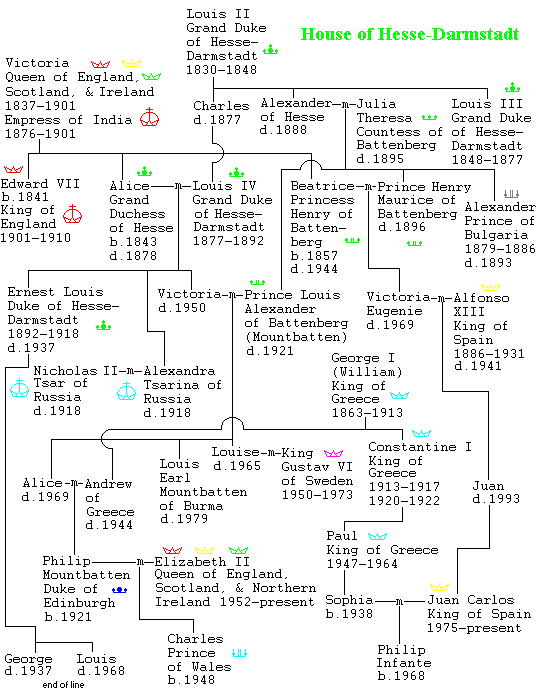 As Queen Victoria's daughter Alice married the Grand Duke Louis IV, one of the Battenberg sons, Louis Alexander, married their daughter, Victoria, while another Battenberg son, Henry Maurice, married Queen Victoria's youngest daughter, Beatrice. Victoria, daughter of Beatrice, married the King of Spain. One of Alice's other daughters, Alexandra, fatefully married Nicholas II of Russia. Alexandra, Nicholas, and all their children, of course were horribly murdered by the Bolsheviks, and their bodies largely destroyed -- now recovered and reburied in St. Petersburg. Alexandra was not popular in Russia, in great measure because of her strange and distraught behavior, which the public at the time did not know was because of the haemophilia of her son, the Tsarevich. Queen Victoria's daughters Alice and Beatrice were both carriers of the trait, which apparently originated with her. Nowhere did the disease have such drastic and tragic consequences as in Alexandra's family. Meanwhile, another Battenberg son, Alexander, was for a time the ruler of Bulgaria.
As Queen Victoria's daughter Alice married the Grand Duke Louis IV, one of the Battenberg sons, Louis Alexander, married their daughter, Victoria, while another Battenberg son, Henry Maurice, married Queen Victoria's youngest daughter, Beatrice. Victoria, daughter of Beatrice, married the King of Spain. One of Alice's other daughters, Alexandra, fatefully married Nicholas II of Russia. Alexandra, Nicholas, and all their children, of course were horribly murdered by the Bolsheviks, and their bodies largely destroyed -- now recovered and reburied in St. Petersburg. Alexandra was not popular in Russia, in great measure because of her strange and distraught behavior, which the public at the time did not know was because of the haemophilia of her son, the Tsarevich. Queen Victoria's daughters Alice and Beatrice were both carriers of the trait, which apparently originated with her. Nowhere did the disease have such drastic and tragic consequences as in Alexandra's family. Meanwhile, another Battenberg son, Alexander, was for a time the ruler of Bulgaria.
 On the map, we see the lands of Hesse. However, the extent of Oberhessen apparently combines the possessions of both Hesse-Cassel and Hesse-Darmstadt. Hesse-Homburg is not even shown. The Rhein-Hessen lands were added to Darmstadt at the Congress of Vienna. Note that Mainz was originally an independent Electoral Archbishopric, all of which were abolished at Vienna.
On the map, we see the lands of Hesse. However, the extent of Oberhessen apparently combines the possessions of both Hesse-Cassel and Hesse-Darmstadt. Hesse-Homburg is not even shown. The Rhein-Hessen lands were added to Darmstadt at the Congress of Vienna. Note that Mainz was originally an independent Electoral Archbishopric, all of which were abolished at Vienna.
South of Darmstadt, in the Odenwald mountains, stands Castle Frankenstein. Yes, Frankenstein. Small and partially reconstructed, this castle looms large just for its name. Mary Shelley got the name "Frankenstein" from someplace, and there is little doubt that it was from here. She certainly traveled nearby, on the way to the Swiss retreat with Lord Bryon and others, where she wrote the novel Frankenstein [1818] during "the year without summer" in 1816. However, we have no evidence that she visited Castle Frankenstein or even heard about it.
This is disappointing, since part of the lore of the castle is the residence of an alchemist, Johann Conrad Dippel (1673-1734), who is said to have experimented with dead bodies. This could be direct inspiraton for Shelley's story. However, it is now hard to tell what stories about Dippel antedate Frankenstein and those that have actually been subsequently inspired by it. Generating extra fame for a local tourist attraction is something commonly heard of; and while Castle Frankenstein seems to generate modest levels of interest, there is a successful restaurant on site, and special events during the year, as at Halloween, draw respectable crowds.
Prince Louis Alexander of Battenberg went on to a distinguished career in the Royal Navy. He was First Sea Lord when World War I began.
During the War, he changed the family name to a more Anglicized "Mountbatten," but still had to resign his position because of his (birth) nationality. Nevertheless, Prince Louis's son went on to his own distinguished career in British service, ultimately as Lord Louis, Earl Mountbatten of Burma. Lord Mountbatten's sister Alice married Prince Andrew of Greece, and their son, Philip, ended up marrying the future Queen Elizabeth. Renouncing his claims to the Greek succession, Philip took the name of his mother's family, Mountbatten, which now passes to the heirs to the British Thone, Prince Charles and his son Prince William. Prince Charles is thus descended from Queen Victoria through both his mother and his father, as well as being descended from Louis II of Hesse in two ways. He regarded Lord Mountbatten, his great uncle, as his "honorary grandfather."
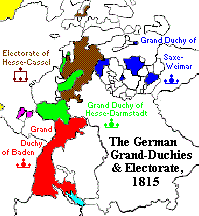 And there are actual Frankensteins around. In 2008, the President of the California Medical Association was Dr. Richard S. Frankenstein, a pulmonologist. Dr. Frankenstein was also Chief Medical Officer of the Hollywood Presbyterian Medical Center, 2016-2017, which happens to be where I was born in 1949. I'm sure many people believe that the California Medical Association should have made Dr. Frankenstein the permanent President of the organization. How could they pass up the chance?
And there are actual Frankensteins around. In 2008, the President of the California Medical Association was Dr. Richard S. Frankenstein, a pulmonologist. Dr. Frankenstein was also Chief Medical Officer of the Hollywood Presbyterian Medical Center, 2016-2017, which happens to be where I was born in 1949. I'm sure many people believe that the California Medical Association should have made Dr. Frankenstein the permanent President of the organization. How could they pass up the chance?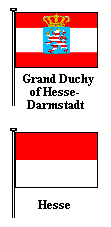
| Dukes & Electors of Saxony | |
|---|---|
| Otto I the Illustrious | 880-912 |
| Duke of Thuringia, 909 | |
| Henry I the Fowler | 912-936 |
| King, 918-936 | |
| Otto I the Great | 936-961/66 |
| King, 936-973;  Emperor, Emperor,962-973 | |
| Hermann Billung | 961/66-973 |
| Bernard I | 973-1011 |
| Bernard II | 1011-1059 |
| Ordulf | 1059-1072 |
| Magnus | 1072-1106 |
| Lothar of Supplinburg, II of Germany | 1106-1137 |
 Emperor, Emperor,1125-1137 | |
| Henry II (IV) Welf, the Proud, X of Bavaria | 1137-1138 |
| Albert I the Bear Ascanian | 1138-1142 |
| Brandenburg, 1134-1170 | |
| Henry III (V) Welf, the Lion | 1142-1180, d.1195 |
| Bernard III Ascanian | 1180-1212 |
| Albert II | 1212-1261 |
| division between Saxe-Lauenburg & Saxe-Wittenberg | |
| Albert III of Saxe-Wittenberg | 1261-1298 |
| Rudolf I | 1298-1356 |
| Rudolf II | Elector, 1356-1370 |
| Wenceslas | 1370-1388 |
| Rudolf III | 1388-1419 |
| Albert IV | 1419-1422 |

A final showdown over the Germany monarchy, which ended up as a Götterdämmerung in which the Monarchy itself foundered, was between the Hohenstaufen and the Welf Dukes of Saxony. The Welf heirs, although apparently the losers, deprived of Saxony (1138, 1180) and Bavaria (1180), were then compensated with Saxon lands, the Duchy of Brunswick, which grew into the Kingdom of Hanover.
In 1261 there is a division between Albert III of Saxe-Wittenberg and his brother John I of Saxe-Lauenburg. Albert's grandson Rudolf II became Elector of Saxony through the Golden Bull of Emperor Charles IV in 1356. The Lauenburg line lasted many years, until 1689, as seen below. But when the male line of Wittenburg failed in 1422, the title of Elector of Saxony passed to the Margraves of Meißen, so that later what became "Saxony" was actually east and south of the original Stem Duchy. That came to be called "Upper Saxony," while the lands around the Lower Elbe were "Lower Saxony." Much of the original western part of Saxony, however, became "Westphalia," so that even "Lower Saxony" is somewhat to the east of the original Duchy.
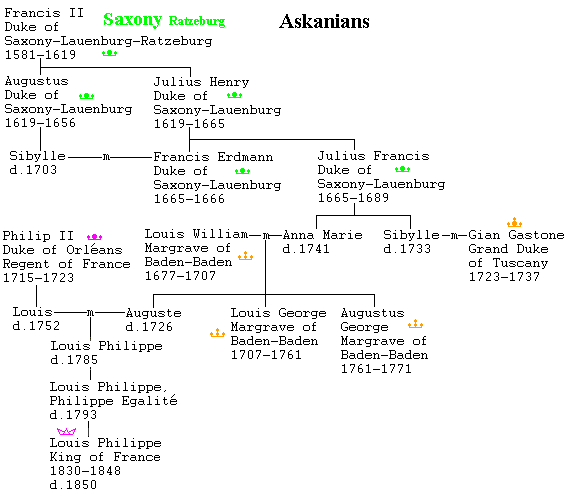
The daughters of Julius Francis, the last Askanian Duke of Saxony, made important marriages. Sibylle married the Gian Gastone, the Medici Grand Duke of Tuscany. Unfortunately, they had no children and were the end of the Medici line. Anna Marie married the great general of the War of the Spanish Succession, Louis William of Baden. Their sons were themselves the last of their line (of Baden-Baden), but they had a sister, Auguste, who married Louis, the Duke of Orléans. All subsequent members of the House of Orléans, including King Louis Philippe of France, indeed all members of the surviving French House of Bourbon, were her descendants.
The genealogy here is now from the Erzählende genealogische Stammtafeln zur europäischen Geschichte, Volume I, Part I, Deutsche Kaiser-, Königs-, Herzogs- und Grafenhäuser I [Andreas Thiele, Third Edition, R. G. Fischer Verlag, 1997]. The list of early Dukes is corrected from the Regentenlisten und Stammtafeln zur Geschichte Europas by Michael F. Feldkamp [Philipp Reclam, Stuttgart, 2002, pp.279-280].
| Dukes, Electors, & Kings of Saxony; Wettins | |||
|---|---|---|---|
| Frederick I the Warlike | Margarve of Meißen, 1381-1423 | William III the Brave | Claimant Duke of Luxemburg, 1439-1482 |
| Duke & Elector, 1423-1428 |
|||
| Frederick II the Gentle | 1428-1464 | ||
| Albertine Line | Ernestine Line | ||
| Albert the Bold | Duke, 1464-1500 | Ernest | Elector, 1464-1486 |
| Henry the Pious | Duke, 1473-1541 | Frederick III the Wise | 1486-1525 |
| George the Bearded | 1500-1539 | John the Constant | 1525-1532 |
| Maurice | Duke, 1541-1553 | John Frederick the Magnanimous | 1532-1547 |
| Elector, 1547-1553 | Duke, 1532-1554 | ||
| Augustus | 1553-1586 | John Frederick II | Duke, 1554-1595 |
| Christian I | 1586-1591 | ||
| Christian II | 1591-1611 | John William | Duke of Saxe-Weimar, 1572-1573 |
| John George I | 1611-1656 |
| John George II | 1656-1680 |
| John George III | 1680-1691 |
| Commanded the Saxon Corps, Center of Christian Relief Army at Siege of Vienna, 1683 | |
|---|---|
| John George IV | 1691-1694 |
| Frederick Augustus I, the Strong | Elector, 1694-1733 |
| King of Poland, 1697-1706, 1709-1733 | |
| Frederick Augustus II | Elector, 1733-1763 |
| King of Poland, 1733-1763 | |
| Frederick Augustus I, (III) the Just | Elector, 1763-1806 |
| King, 1806-1827 | |
| Grand Duke of Warsaw, 1807-1815 | |
| Anthony Clement | 1827-1836 |
| Maximillian | Duke, 1830-1838 |
| Frederick Augustus II | 1836-1854 |
| John | 1854-1873 |
| German Empire, 1871 | |
| Albert | 1873-1902 |
| George | 1902-1904 |
| Frederick Augustus III | 1904-1918, d. 1932 |
For many years Electoral Saxony appeared in no way inferior in power to its neighbor Brandenburg. The Electors Frederick Augustus I and Frederick Augustus II were even elected Kings of Poland. Not until Frederick II of Prussia did it start to become clear that Saxony would not be the predominant power of the region. An attempt was made to remedy this through alliance with France during the Napoleonic Era, but all this ended up earning Saxony was a significant loss of territory, to Prussia of course, at the Congress of Vienna.  Saxony was reduced to parity with Württemberg as one the smallest of the five Kingdoms of Germany. As such, it was never again a major player in German politics.
Saxony was reduced to parity with Württemberg as one the smallest of the five Kingdoms of Germany. As such, it was never again a major player in German politics.
The capital of the Electorate and Kingdom of Saxony was Dresden, a beautiful city that later became one of the symbols of the horrors of World War II, when the Allies firebombed it on February 13, 1945. This killed perhaps 135,000 people and all but destroyed the city. A witness was Allied prisoner-of-war and future novelist Kurt Vonnegut, whose Slaughterhouse-Five (1969) recounts his experience (in a science fiction context).
The genealogical tables began with Brian Tompsett's Royal and Noble genealogy. This left many gaps, which I had trouble finding convenient sources to remedy. After some frustrating and fruitless library work, Christopher Haußmann of Munich came to the rescue. Besides having put together some information himself, he could refer me to two German websites: Dresden used to give the Electors and Kings of Saxony, while Thüringen used to cover all the Dukes. These pages are not necessarily in the most convenient form, they are in German, and I am not now able to find their historical sections; but most of the gaps and problems left by Tompsett were resolved by them.
I have now obtained the Erzählende genealogische Stammtafeln zur europäischen Geschichte, Volume I, Part I, Deutsche Kaiser-, Königs-, Herzogs- und Grafenhäuser I [Andreas Thiele, Third Edition, R. G. Fischer Verlag, 1997], which exhaustively covers all this genealogy, and I will be checking and supplementing the information from these other sources as time allows.
 The table covers all the Wettin Electors and Kings of Saxony. The Electorate first passes down the senior "Ernestine" line. When the Emperor Charles V defeated the Elector John Frederick and the Protestant League of Schmalkalden at Mühlberg in 1547, he transferred the Electorate to Maurice of the "Albertine" line, where it remained, leading to the Kingdom of Saxony. The Ernestine line then produces all the Dukes of Saxony, shown below.
The table covers all the Wettin Electors and Kings of Saxony. The Electorate first passes down the senior "Ernestine" line. When the Emperor Charles V defeated the Elector John Frederick and the Protestant League of Schmalkalden at Mühlberg in 1547, he transferred the Electorate to Maurice of the "Albertine" line, where it remained, leading to the Kingdom of Saxony. The Ernestine line then produces all the Dukes of Saxony, shown below.
The claim of William the Brave to Luxemburg derived from his wife, Anna of Hapsburg, who was a granddaughter of the Emperor Sigismund of Luxemburg. The generally recognized heiress of Luxemburg, however, was Elizabeth of Görlitz, Sigismund's niece; and William doesn't seem to have made much headway with his claim, especially when Anna died in 1462.
The elections of Frederick Augustus I and II as Kings of Poland did not add measurably to the power of Saxony, since Poland itself was becoming all but ungovernable and would only even exist for 30 more years after them. The episodes may have damaged Saxony in the long run, by drawing the Electors away from domestic improvements.
The Kingdom of Saxony, created by Napoleon, never had much of a chance, apart from French help, to contend against the other German powers. Prussia greatly reduced Saxon territory at the Congress of Vienna.
Napoleon also made Augustus III, now the First of Saxony, not just King of Saxony, but Grand Duke of Warsaw, in Napoleon's attempt to revive the Polish State. This didn't do the Poles any good, and it did not help makes friends for Saxony among the Allies of 1815. This was the last time that Saxony had anything to do with Poland.
The line of Kings of Saxony continued until 1918, when all the German rulers abdicated. The last King, Frederick Augustus III, although reduced to a private citizen, did nevertheless represent the Senior Line of the House of Saxony. This would count for something in some circles.
As happens with deposed royality and nobility, the meaningless succession as Head of House ends up disputed. We see that sort of thing with the Bonapartes. With Saxony, the problem would be lack of heirs. Both Maria Emanuel and Albert would have no legitimate children. So Maria Emanuel, as Head of House, designated his nephew Alexander, the son of his sister, Anna. This was allowed by most, since Saxony did not strictly follow the Salic Law. However, Maria Emanuel's cousins, descended from his aunt, Margareta Karola, who are now Princes of Hohenzollern, claimed priority. This is already the senior line of the Princes of Hohenzollern, so you might think that, when it comes of meaningless titles, they would have enough already. But Saxony was, after all, a Kingdom, so perhaps that is too good to pass up. It is hard to imagine that there would be a court that might wish to sort this out.
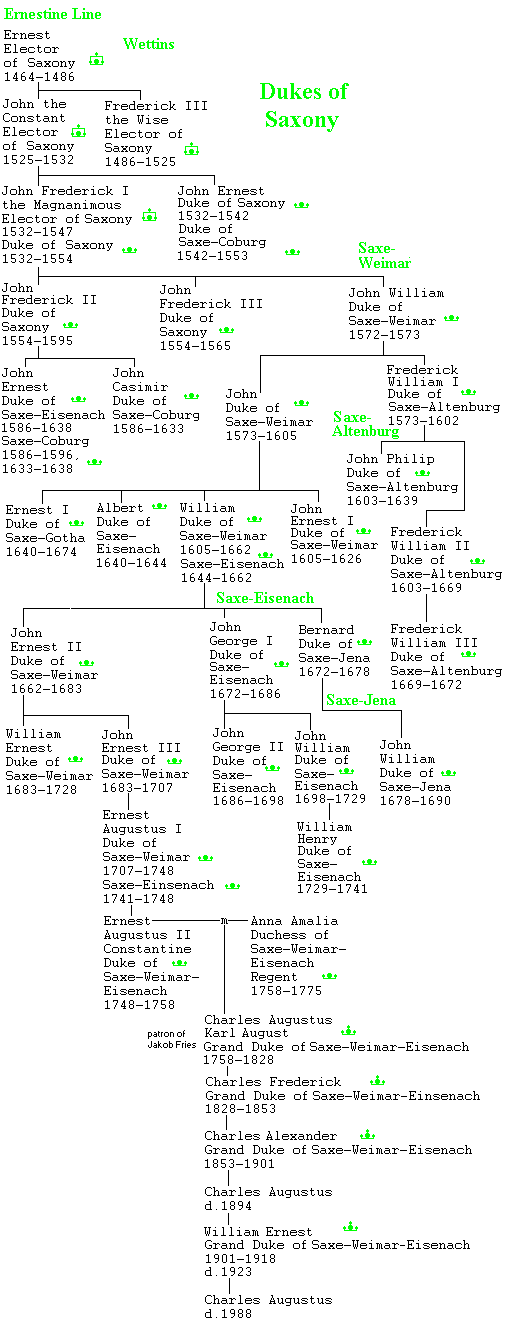
Saxe-Weimar was the principal Duchy of Saxony. In 1815 it was styled a "Grand Duchy." (I was not clear when this happened but now have been referred to a (now dead) website that gives the date.) The celebrated Grand Duke Charles Augustus (Karl August) was the friend of Goethe and the protector of Jakob Fries. When Prussia demanded that Fries be prohibited from teaching philosophy, the Duke found him something else to do at Jena, teach physics. Charles Augustus was also the first German prince to grant a constitution. This doesn't sound very exciting now, but it was radical stuff in post-Napoleonic Germany.
There were many regencies in the indicated reigns. Some Dukes didn't even come of age before a premature death. The web source for the Duchies lists reigns minus the regencies. I have largely disregarded the regencies, which would add greatly to the clutter of the diagrams, and have added the regency periods to the reigns proper of the Dukes. One regency is shown, that of the celebrated mother, Anna Amalia, of Charles Augustus.
In 1815 the Kingdom of Saxony existed alongside the Grand Duchy of Saxe-Weimar(-Eisenach) and the Duchies of Saxe-Gotha(-Altenburg), Saxe-Meiningen (also seen spelled "Meinungen"), Saxe-Hildburghausen, and Saxe-Coburg(-Saalfeld). These "Saxon Duchies" were the territorially most complicated part of Germany in that era, as can be seen in the maps of the German Confederation. The beginning of each division can be seen in the genealogical tables above and below.
In 1826 a some significant rearrangement occurred: Duke of Ernest I of Saxe-Coburg took over Saxe-Gotha, of which his wife, Louise, was heiress. This created the Duchy of Saxe-Coburg-Gotha, from which Ernest's son Albert married Queen Victoria of England. Albert's elder brother, Ernest II, succeeded to the Duchy; but when Ernest died in 1893, the Duchy was passed to Albert and Victoria's son Alfred, and when he died in 1900, to their grandson Charles Edward. Charles was still Duke in 1918 when all the old feudal thrones were abolished. Although Albert 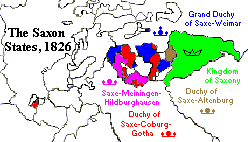 and King Edward VII of England are usually said to be of the House of Saxe-Coburg-Gotha, the whole family of the House of Saxony, of course, was actually that of the Wettins. Although the name "Windsor" was adopted for the British Royal Family in World War I, Queen Elizabeth II is still really a Wettin, descended from Duke and Elector Frederick I of Saxony.
and King Edward VII of England are usually said to be of the House of Saxe-Coburg-Gotha, the whole family of the House of Saxony, of course, was actually that of the Wettins. Although the name "Windsor" was adopted for the British Royal Family in World War I, Queen Elizabeth II is still really a Wettin, descended from Duke and Elector Frederick I of Saxony.
With the consolidation of Saxe-Gotha and Saxe-Coburg in 1826, some other changes look place. Saxe-Altenburg was detached from Saxe-Gotha and given to the Duke of Saxe-Hildburghausen, who then passed his original domain to Saxe-Meiningen. The consolidation of those two Duchies creates something remarkable -- a continuous piece of land. The German website doesn't seem to list Hildburghausen with Saxe-Meiningen after 1866, so I wonder if Prussia took it -- or if the duality was just overlooked. All these cities, by the way, can be seen on a modern map of Germany, in the State of Thuringia, lately part of unhappy East Germany.
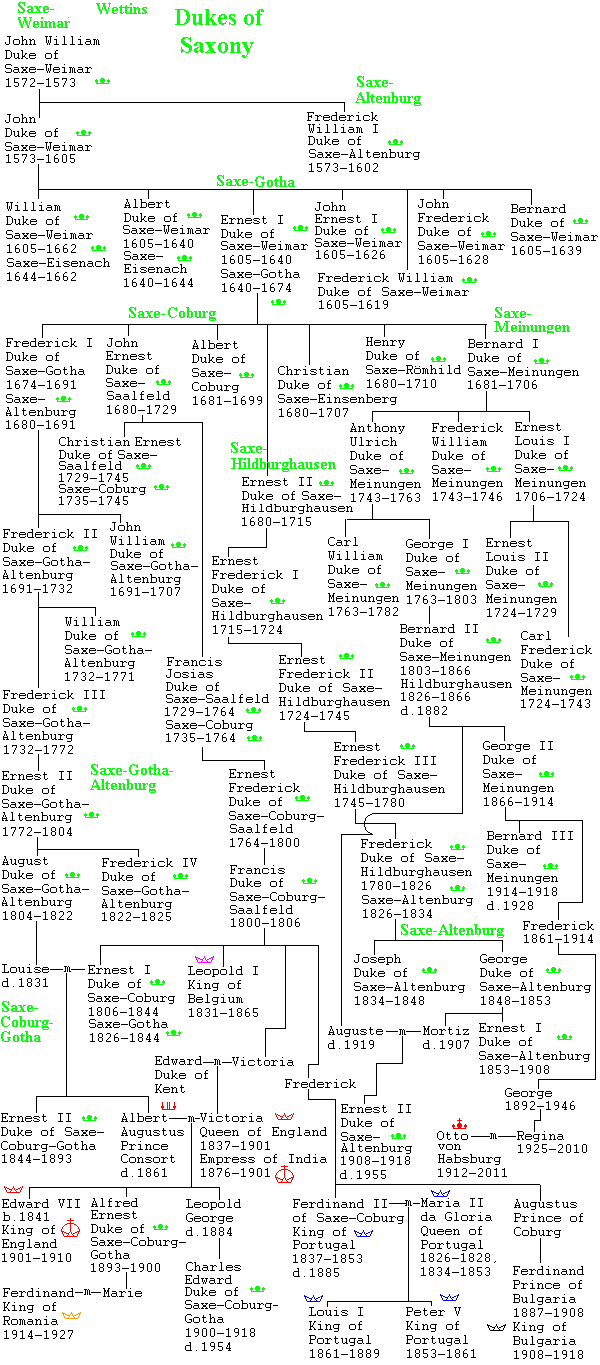
The many families of the Saxon Kingdom and Duchies ended up providing a resource of noble personages for the rest of Europe. Besides a husband for Queen Victoria, Saxe-Coburg alone also provided spouses for many others, especially when Victoria's many children are counted, and Kings for Belgium, Portugal, and Bulgaria. Victoria's own mother, where her previously non-English name derived, was a sister of Duke Ernest I, as can be seen above.
House of Welf-Brunswick-Lüneburg
Dukes of Brunswick, Electors & Kings of Hanover
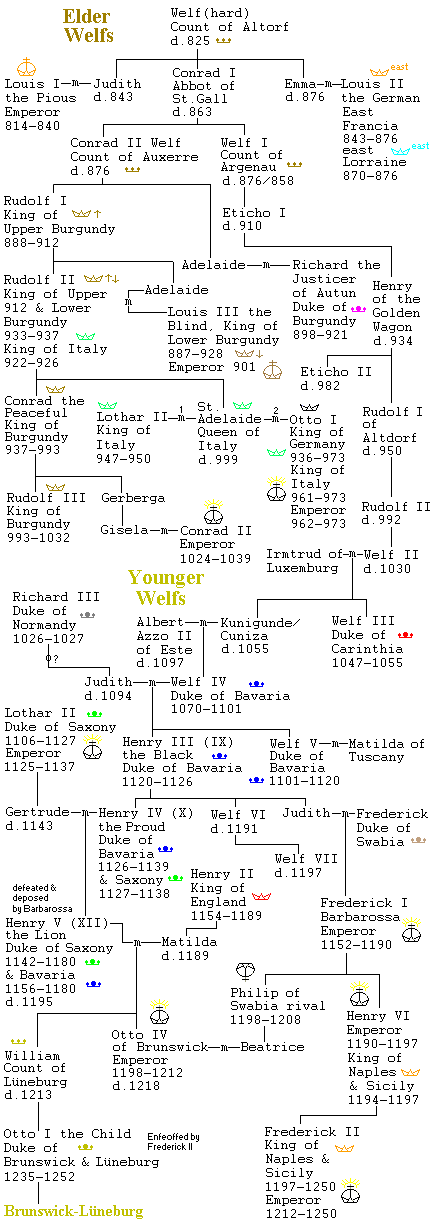 The story of the House of Brunswick begins much earlier, back in the young days of the Carolingian Empire. The House of Welf contributed some Carolingian wives and then, as the Empire began to split up, came into possession of the Kingdom of Burgundy. This led to marriages to German royal houses, and then to Burgundy itself passing to the German Emperors. Meanwhile, a collateral line of German Welfs grew into powerful nobility. Although the male line ended, a scion of Este who married the Welf heiress fathered what was nevertheless considered a continuation of the Welf house, the "Younger Welfs." These figured in contention for the Imperial Throne with their own cousins, the Hohenstaufen Dukes of Swabia.
The story of the House of Brunswick begins much earlier, back in the young days of the Carolingian Empire. The House of Welf contributed some Carolingian wives and then, as the Empire began to split up, came into possession of the Kingdom of Burgundy. This led to marriages to German royal houses, and then to Burgundy itself passing to the German Emperors. Meanwhile, a collateral line of German Welfs grew into powerful nobility. Although the male line ended, a scion of Este who married the Welf heiress fathered what was nevertheless considered a continuation of the Welf house, the "Younger Welfs." These figured in contention for the Imperial Throne with their own cousins, the Hohenstaufen Dukes of Swabia.
The conflict of the Welfs with the Waiblingen, the Hohenstaufen (or Staufer), was reflected in Italy, where the terms Guelf and Ghibelline were identified with, respectively, the Papal and the Imperial parties. These were alliances of convenience, of course, and the Welf Emperor, Otto IV, was not necessarily more pro-Papal than any other German Emperor. But in Germany, the Welf cause, although weakening the state, was not fated for much success. The defeat of Henry the Lion by Frederick I (when Bavaria was conferred upon the Wittelsbachs, who retained it thereafter) and then of Otto IV by Philip of Swabia and the supporters of his nephew, Frederick II, doomed further Welf prospects. As Emperor, however, Frederick endowed Otto IV's nephew, Otto the Child, with part of the original Duchy of Saxony. This was now a Duchy associated with the cities of Brunswick (Braunschweig), and Lüneburg. In it the Welf house would survive, though increasingly identified in name and ambition with its new home. An entire website about the Welfs, continuing down to the present, exists in Germany.
| Dukes of Brunswick-Lüneburg, Electors & Kings of Hanover | |||||||
|---|---|---|---|---|---|---|---|
| Ernest the Confessor | Duke of Brunswick- Lüneburg, 1520-1546 | ||||||
| Francis Otto | 1546-1559 | William the Pious | 1559-1592 | ||||
| Ernest II | 1592- 1611 | Christian | 1611- 1633 | Augustus the Elder | 1633- 1636 | Frederick | Duke of Brunswick- Celle, 1636- 1648 |
| George Odysseus | 1636-1641 | ||||||
| Ernest Augustus | Duke of Brunswick- Lüneburg, 1679- 1698; Duke of Hanover, 1680- 1698 | Christian Louis | 1641- 1655 | John Frederick | 1665- 1679 | George William | Duke of Brunswick- Celle, 1665- 1705 |
| Elector of Hanover, 1692- 1698 | |||||||
| George I | 1698-1727 | King of England, 1714-1727 |
| George II | 1727-1760 |
| King of England, 1727-1760 | |
| George III | 1760-1806 |
| King of England, 1760-1820 | |
| King of Hanover, 1814-1820 | |
| George IV | 1820-1830 |
| King of England, 1820-1830 | |
| William (IV) | 1830-1837 |
| King of England, 1830-1837 | |
| Ernest Augustus | 1837-1851 |
| George V | 1851-1866 d.1878 |
| Hanover annexed by Prussia, 1866 | |
|---|---|
In time, as attempts were made to institute primogeniture, smaller principalities or duchies (secundogenitures) might be created for younger sons and cousins. The main line of Brunswick was associated with the capital of Lüneburg, while subsidiary domains were created for younger sons, especially in Dannenberg, Wolfenbüttel, Hannover, and Celle. My information on the details of this is spotty. The only domain that eventually became permanently separated from the larger was the Duchy of Brunswick-Wolfenbüttel. In time, that became simply the Duchy of Brunswick, as the larger Duchy, in turn, acquired a new name. That began with the creation of a Principality of Hannover -- usually written Hanover in English -- in 1638. When all but one of the sons of William the Pious (or the Younger) died without male issue, and all of the sons of George Odysseus followed suit, Ernest Augustus reassembled most of the Duchy and then elevated Hanover to Duchy status. When his brother George William, who was rulling Brunswick-Celle and whose daughter Ernest Augustus had married, died in 1705, the whole Duchy was reassembled, except for Brunswick-Wolfenbüttel. The larger Duchy, however, now began to be called Hanover, especially when Ernest Augustus was made an Elector of the Holy Roman Empire in 1692, as "Elector of Hanover." The marriage of Ernest Augustus to a granddaughter of James I of England then gave his son George a claim to the Throne of England and Scotland, realized with the "Hanoveran Succession" in 1714.
The line of the Welfs, defeated in Germany, thus many years later came to the powerful Throne of Great Britain and Ireland. The British Parliament was always suspicious of the German interests of the Hanoveran Kings, but Hanover naturally found itself in anti-French alliances just like Britain. After the paroxysm of the French Revolution and Napoleonic Wars, when Hanover was usually under French occupation, the Electorate emerged as one of the Kingdoms of Confederation Germany.
After the paroxysm of the French Revolution and Napoleonic Wars, when Hanover was usually under French occupation, the Electorate emerged as one of the Kingdoms of Confederation Germany.
A fateful parting of the ways came in 1837, when Queen Victoria came to the Throne in Britain. The Salic Law prohibited female succession, and Hanover passed to her uncle, Ernest Augustus. In 1866, his son, George V, picked the wrong side in the war between Prussia and Austria. The Prussians occupied Hanover and deposed George, who was thrown upon the hospitality of his English cousin.
That is not quite the end of the story, however. In 1884 the line of the Dukes of Brunswick, of Brunswick-Wolfenbüttel that is, came to an end. The son of George V, Ernest Augustus, was the heir. He could have assumed the rule of Brunswick, such as it was under the German Empire, if he had acknowledged the loss of Hanover proper by his family. He refused, and the Ducal Throne remained vacant. As it happened, however, his son, yet another Ernest Augustus, ended up marrying a daughter, Victoria Louise, of Wilhelm II, in 1913. They were endowed with the Duchy. Such enjoyment as they may have derived from this was short-lived, since they were deposed, with all German royalty and ruling nobility, in 1918.
Their grandson, yet even another Ernest Augustus, emerged on the radar screen of popular celebrity in 1999 by marrying Princess Caroline of Monaco. Their daughter, Alexandra, however, would not be the heiress of Hanover (apart from the Salic Law), since the now obligatory next Ernest Augustus had already been produced by a previous marriage.
The genealogical table below was originally almost entirely based on Brian Tompsett's Royal and Noble genealogy. This left the exact mechanism of the subdivisions obscure. Some of that could be clarified, a little, with Bruce R. http://my.raex.com/~obsidian/regindex.html's Regnal Chronologies. The Dukes of Brunswick-Wolfenbüttel are given separately. Now, however, I have been able to make some additions and corrections here using the Erzählende genealogische Stammtafeln zur europäischen Geschichte, Volume I, Part I, Deutsche Kaiser-, Königs-, Herzogs- und Grafenhäuser I [Andreas Thiele, Third Edition, R. G. Fischer Verlag, 1997].

| Dukes of Brunswick, Brunswick-Wolfenbüttel | |
|---|---|
| Augustus the Younger | 1635-1666 |
| Rudolf Augustus | 1666-1704 |
| Anthony Ulrich | 1704-1714 |
| Augustus William | 1714-1731 |
| Louis Rodolph | 1731-1735 |
| Ferdinand Albert | 1735 |
| Charles I | 1735-1780 |
| Charles II | 1780-1806 |
| Ferdinand William | 1806-1815 |
| Charles III Frederick | 1815-1830 d.1873 |
| William Maximilian | 1830-1884 |
| interregnum, 1884-1913 | |
| Ernest Augustus | 1913-1918 d.1953 |
The most striking thing about the genealogy of the Dukes of Brunswick here are the marriages of the daughters of Louis Rodolph, Prince of Blackenbourg. One daughter married a Romanov and was the mother of a Tsar, albeit an ephemeral one; but then another married the Emperor Charles VI and become the fateful mother of Maria Theresa, who for forty years was herself the House of Hapsburg.
| Counts, Dukes, & Grand Dukes of Oldenburg | |
|---|---|
| Egilmar I | Count, 1091-1108 |
| Egilmar II | 1108-1142 |
| Christian I the Quarrelsome | 1143-1167 |
| Maurice/Moritz I | 1167-1211, d.1218 |
| Christian II | 1211-1233 |
| Otto I | 1232-1252 |
| John I (IX) | 1243-1270 |
| Christian III | 1270-1285 |
| John II (X) | 1272-1316 |
| Christian IV | 1302-1322 |
| John III (XI) | 1302-1342(?) |
| Conrad I | 1313-1347 |
| Conrad II | 1342-1401 |
| Christian V | 1342-1399 |
| Maurice II | 1385-1420 |
| Dietrich the Lucky | 1399-1440 |
| Christian | King of Denmark, 1448-1481 |
| Gerhard VI the Quarrelsome | 1440-1482 d.1500 |
| John V (XIV) | 1482-1526 |
| John VI (XV) | 1526-1529, d.1548 |
| George | 1526-1529, d.1551 |
| Christopher | 1526-1529, d.1566 |
| Anthony/Anton I | 1526-1573 |
| John VII (XVI) | 1573-1603 |
| Anthony Gunther | 1603-1667 |
| Anthony II | 1573-1619 |
| Count of Delmenhorst 1577-1619 | |
| Anthony Henry | Delmenhorst, 1619-1622 |
| Christian | Delmenhorst, 1619-1647 |
| to Denmark, 1667-1773 | |
| Oldenburg-Schleswig- Holstein-Gottorp | |
| Frederick Augustus | Duke, 1774-1785 |
| Peter Frederick William | 1785-1810, Grand Duke, 1814-1823 |
| to France, 1810-1814 | |
| Peter Frederick Louis | 1823-1829 |
| Paul Frederick Augustus | 1829-1853 |
| Nicholas Frederick Peter | 1853-1900 |
| Frederick Augustus | 1900-1918, d.1931 |
When the main lineage of Oldenburg itself died out in 1667, it fell to the Danish House. One of the line of Holstein-Gottorp married a daughter of Peter the Great of Russia. Another, his first cousin, had Oldenburg settled upon him. One of his brothers became King of Sweden. Another had a son to whom Oldenburg passed in 1823. Subsequent Grand Dukes were all his descendants. Some of this genealogy can be examined below.

The original table here was based on Brian Tompsett's Royal and Noble genealogy and Bruce R. Gordon's Regnal Chronologies. This is now modified and expanded on the basis of the Geschichte des Landes Oldenburg, by Albrecht Eckhardt and Heinrich Schmidt [Heinz Holzberg Verlag, Oldenburg, 1987]. Some slight inconsistencies in dating (and the numbering of the Johns) have been rather arbitrarily resolved. Some obscurities remain.
| Dukes & Margraves of Thuringia | |
|---|---|
| Thakulf | c.849-874 |
| Radulf | 874-880 |
| Poppo | 880-892 |
| Konrad | 892-906 |
| Burchard II of Wettin | 907-909 |
| to the Duke of Saxony, 909 | |
| Dukes of Thuringia | |
| Ekkehard | 1000-1002 |
| Wilhelm II of Weimar | 1002-1003 |
| Landgraves of Thuringia | |
| Louis I the Bearded, the Salian | Count, 1031-1056 |
| Wilhelm IV of Weimar | Duke, 1046-1062 |
| Louis II the Jumper | Count, 1056-1123 |
| Otto of Weimar | Duke, 1062-1067 |
| Louis III | Landgrave, 1123-1140 |
| Louis IV the Iron | 1140-1172 |
| Louis V the Mild | 1172-1190 |
| Herman I | 1190-1216 |
| Louis VI the Pious | 1216-1227 |
| Herman II | 1227-1241 |
| Henry Raspe | 1241-1247 |
| Rival Emperor, 1246-1247 | |
| to March of Meißen | |
| Margraves of Meißen | |
|---|---|
| Frederick | 928-965 |
| Rikdag of Harzgau | 965-985 |
| Ekkehard I of Merseburg | 985-1002 |
| Gunzelin | 1002-1010 |
| Hermann | 1010-1031 |
| Ekkehrd II | 1031-1046 |
| Wilhelm of Weimar | 1046-1062 |
| Otto | 1062-1067 |
| Egbert I of Brunswick | 1067-1068 |
| Egbert II | 1068-1089 |
| Henry I of Wettin | 1089-1103 |
| Thimo | 1103 |
| Henry II | 1103-1123 |
| Wiprecht of Groitzsch | 1123-1124 |
| Henry III | 1124-1135 |
| Hermann II of Winzenburg | 1124-1129 |
| Wettins | |
| Conrad the Great | 1129-1156, d.1157 |
| Otto the Rich | 1156-1190 |
| Albert I the Proud | 1190-1195 |
| Dietrich | 1198-1221 |
| Henry IV the Illustrious | 1221-1288 |
| Albert II the Decadent | 1288-1307, 1314 |
| Frederick Tuta | 1288-1291 |
| Frederick I | 1291-1323 |
| Frederick II the Solemn | 1323-1349 |
| Frederick III the Harsh | Ostland, 1349-1381 |
| William One-Eye | 1349-1407 |
| Balthasar | Thuringia, 1349-1406 |
| Frederick IV the Warlike/ Quarrelsome, I of Saxony | 1381-1423 |
| Duke of Saxony, 1423-1428 | |
| Frederick V | Thuringia, 1406-1440 |
| to Saxony | |
Lists and treatments of the Thuringian Dukes seem to be curiously hard to come by, and I have relied on a single historical website. The genealogy of the Landgraves, which I have not yet reproduced here, can be found in the Erzählende genealogische Stammtafeln zur europäischen Geschichte, Volume I, Part 1, Deutsche Kaiser-, Königs-, Herzogs- und Grafenhäuser I [Andreas Thiele, Third Edition, R. G. Fischer Verlag, 1997, pp.233-234].

One reason for the withering of Thuringia may have been the vigorous Marches that grew on the eastern border. These soon overshadowed what should have been the parent Duchy. In 1247, the Margrave of Meißen, Henry the Illustrious of Wettin, acquired the Landgravate of Thuringia, which then lost its separate and original identity. The Landgrave Henry Raspe had forfeited his domain with rebellion against the Emperor Frederick II (away in Sicily) and his son King Conrad IV (in Germany).
Meißen had been going since 928. A number of families contended for the Margavate. Except for Rikdag, they are not given here, but genealogies for five are shown by Andreas Thiele in the cited Stammtafeln [pp.235-236]. The Wettins were the sixth family, actually descended from the last of the original Dukes of Thuringia, Burchard; and under Conrad the Great they secured exclusive possession. In 1423, the Wettins became the Dukes of Saxony -- the opposite of the dynamic in 909. Because of this, the whole area of Meißen, Thuringia, Lusatia, and Brandenburg began to acquire the identity that it mostly still has, as "Upper Saxony."
The early marriages of Meißen are of great interest. We have a connection to the Angeli, the Babenbergs of Austria, the Hohenstaufen, and even the Plantagenets.
The whole later complex of the Saxon Duchies was ruled by the large numbers of the House of Wettin. Since one of these, Prince Albert of Saxe-Coburg-Gotha, later married Queen Victoria of England, the subsequent British Royal Family, down to Queen Elizabeth, have been Wettins, direct patrilineal descendants of the Duke Burchard of Thuringia and the Margrave Conrad the Great of Meißen.
The lineage of the Wettins down to Frederick the Warlike, the first Duke of Saxony, is entirely from the Erzählende genealogische Stammtafeln zur europäischen Geschichte, Volume I, Parts 1, Deutsche Kaiser-, Königs-, Herzogs- und Grafenhäuser I [Andreas Thiele, Third Edition, R. G. Fischer Verlag, 1997, pp.237-245]. The website cited for the Dukes of Thuringia above gives a somewhat different list for the Wettin Margraves of Meißen. Here I have followed Thiele and the Regentenlisten und Stammtafeln zur Geschischte Europas, by Michael F. Feldkamp [Philipp Reclam, Stuttgart, 2002, pp.316-317].
| Dukes of Swabia | |
|---|---|
| Erchanger | 915-917 |
| Burkhard I | 917-926 |
| Herman I | 926-949 |
| Ludolph | 950-954, d.957 |
| Burkhard II | 954-973 |
| Otto I | 973-982 |
| Conrad I | 983-997 |
| Herman II | 997-1003 |
| Herman III | 1003-1012 |
| Ernest I of Babenberg | 1012-1015 |
| Ernest II | 1015-1030 |
| Herman IV | 1030-1038 |
| Henry I, III of Germany | 1038-1045, d.1056 |
| Franconia, 1039-1056 | |
| Carinthia, 1039-1047 | |
| Bavaria, 1042-1047 | |
 Emperor, Emperor,1039-1056 | |
| Otto II of Ezzo | 1045-1047 |
| Otto III of Schweinfurt | 1048-1057 |
| Rudolph of Rheinfelden | 1057-1077, d.1080 |
| Frederick I Hohenstaufen | 1079-1105 |
| Frederick II | 1105-1147 |
| Frederick III, Barbarossa, II of Germany | 1147-1152 |
 Emperor, Emperor,1152-1190 | |
| Frederick IV of Rothenburg | 1152-1167 |
| Frederick (V) | 1167-1170 |
| Frederick V Conrad | 1170-1191 |
| Conrad II | 1191-1196 |
| Philip of Swabia | 1196-1208 |
| Rival Emperor, 1198-1208 | |
| Otto IV Welf of Brunswick | 1208-1212 |
 Emperor, Emperor,1198-1212, d.1218 | |
| Frederick VI, II of Germany | 1212-1216 |
 Emperor, Emperor,1212-1250 | |
| Henry II | 1216-1235, 1242 |
| Conrad III, IV of Germany | 1235-1254 |
| Emperor, 1250-1254 | |
| Conrad IV (Conradin) | 1254-1268 |
| Rudolf of Hapsburg | 1289-1290 |
| Emperor, 1273-1291 | |
| John Parricide | 1290-1313 |
The Dukes of Swabia went on to become the last great house of German Emperors, the Hohenstaufen, before the possibility of a strong, united German state disappeared. The contest between the Hohenstaufen and the Welfs even briefly raged over Swabia itself. Then, with victory, the Emperor Frederick II relocated to his inheritance in Sicily. Germany largely disintegrated, including Swabia. Württemberg and Baden became the major successor states.
Other small German states derived from Swabia, like Leichtenstein and Hohenzollern.  More significantly, Alsace (Alsatia, Elsaß), on the left bank of the Rhine, was part of Swabia. Parts of Alsace went to France at the Peace of Westphalia, which ended the Thirty Years war in 1648. Louis XIV subsequently began unilaterally annexing more of Alsace. When he took the Imperial City of Straßburg (now Strasbourg in French) in 1681, the consternation of Germany, and even of Europe, was great. Alsace was German, not French, speaking (unlike other territories allowed to France at Westphalia, such as parts of Lorraine) -- indeed, Alsatian constituted a distinct dialect of High German (where we get Strossburi for Strasbourg). And it also included a Jewish community. The Jews had been expelled from France in 1306, but were (until the 20th century) tolerated (with some memorable exceptions) in Germany. As it happened, Louis did not enforce his Revocation of the Edit of Nantes (1685) in Alsace, so the area preserved most of its religious freedom through the rest of the Ancien Régime. The only reason Louis XIV targeted the region was to obtain the Rhine boundary that had belonged to ancient Gaul. The first effort to rescue the city, during the War of the League of Augsburg (1688-1697), failed, and French possession was confirmed in the Treaty of Ryswick (1697). Alsace was not happy under French rule, and German Emperors subsequently always vowed to recover Alsace.
More significantly, Alsace (Alsatia, Elsaß), on the left bank of the Rhine, was part of Swabia. Parts of Alsace went to France at the Peace of Westphalia, which ended the Thirty Years war in 1648. Louis XIV subsequently began unilaterally annexing more of Alsace. When he took the Imperial City of Straßburg (now Strasbourg in French) in 1681, the consternation of Germany, and even of Europe, was great. Alsace was German, not French, speaking (unlike other territories allowed to France at Westphalia, such as parts of Lorraine) -- indeed, Alsatian constituted a distinct dialect of High German (where we get Strossburi for Strasbourg). And it also included a Jewish community. The Jews had been expelled from France in 1306, but were (until the 20th century) tolerated (with some memorable exceptions) in Germany. As it happened, Louis did not enforce his Revocation of the Edit of Nantes (1685) in Alsace, so the area preserved most of its religious freedom through the rest of the Ancien Régime. The only reason Louis XIV targeted the region was to obtain the Rhine boundary that had belonged to ancient Gaul. The first effort to rescue the city, during the War of the League of Augsburg (1688-1697), failed, and French possession was confirmed in the Treaty of Ryswick (1697). Alsace was not happy under French rule, and German Emperors subsequently always vowed to recover Alsace.
 The French Revolution may have changed that. Alsatians became enthusiastic Revolutionaries -- or so I'm told. The Marseillaise was composed in Strasbourg. Other Alsatians, however, fled the Revolution to Germany, or even to Russia. Then, at long last, Germany recovered Alsace, in 1871, to be incorporated into the new German Empire. Although some Alsatians were glad, most had (reportedly) become French patriots, and substantial numbers, over 100,000, fled to France. Germany made no friends, however, among either French or German speakers, by treating the region like a African colony, ruled directly from Berlin, not like a real part of Germany, with local government. France vowed revenge and, after the incredible carnage of World War I, recovered the region. The names of Alsatian cities, however, despite some spelling differences, still largely betray their German origin. Thus, we have Mulhouse (Mülhausen in German), Altkirch, Ensisheim, Niederbronn, Reichshoffen, Pfaffenhoffen, Hochfelden, Kœnigsbourg (Königsburg), and even Kaysersberg (Kaisersberg). In 1999 the French Institut National de la Statistique et des Études Économiques (INSEE) counted 548,000 adult speakers of Alsatian German in Alsace, or 39% of the adult population -- though only about 25% of children could speak it. Since France has only one official language -- French -- Alsatian German, although officially listed as one of the languages of France, and the second most spoken regional language, is certainly on the decline and under pressure from the educational and political establishment. I am surprised that it survives as much as it does.
The French Revolution may have changed that. Alsatians became enthusiastic Revolutionaries -- or so I'm told. The Marseillaise was composed in Strasbourg. Other Alsatians, however, fled the Revolution to Germany, or even to Russia. Then, at long last, Germany recovered Alsace, in 1871, to be incorporated into the new German Empire. Although some Alsatians were glad, most had (reportedly) become French patriots, and substantial numbers, over 100,000, fled to France. Germany made no friends, however, among either French or German speakers, by treating the region like a African colony, ruled directly from Berlin, not like a real part of Germany, with local government. France vowed revenge and, after the incredible carnage of World War I, recovered the region. The names of Alsatian cities, however, despite some spelling differences, still largely betray their German origin. Thus, we have Mulhouse (Mülhausen in German), Altkirch, Ensisheim, Niederbronn, Reichshoffen, Pfaffenhoffen, Hochfelden, Kœnigsbourg (Königsburg), and even Kaysersberg (Kaisersberg). In 1999 the French Institut National de la Statistique et des Études Économiques (INSEE) counted 548,000 adult speakers of Alsatian German in Alsace, or 39% of the adult population -- though only about 25% of children could speak it. Since France has only one official language -- French -- Alsatian German, although officially listed as one of the languages of France, and the second most spoken regional language, is certainly on the decline and under pressure from the educational and political establishment. I am surprised that it survives as much as it does.
Meanwhile, the Parliament of the European Union now meets in Strasbourg. The government of the European Union is a poorly conceived, undemocratic, and oppressive system, but it's nice that Strasbourg now possesses greater European prominence than it may have had since the Oaths of Strasbourg in the 9th century.
The rest of Swabia would largely be taken up by what would become the Grand Duchy of Baden and the Kingdom of Württemberg.
The list is based on the Regentenlisten und Stammtafeln zur Geschichte Europas by Michael F. Feldkamp [Philipp Reclam, Stuttgart, 2002, pp.282-284]. The genealogy below is from the Erzählende genealogische Stammtafeln zur europäischen Geschichte, Volume I, Part 1, Deutsche Kaiser-, Königs-, Herzogs- und Grafenhäuser I [Andreas Thiele, Third Edition, R. G. Fischer Verlag, 1997].
In the genealogy we see periods where the succession is tending to become hereditary, but then either the male line ends, and the succession jumps to an in-law, or an Emperor, especially Henry III (I of Swabia), grants the Duchy to vassals from outside his family. With the Salians, the Duchy and then the Throne end up in the hands of the Hohenstaufen. The marriages of Gisela (d.1043) not only bring the Kingdom of Burgundy into the Empire, but they lead of into a couple of non-Wettin Margraves of Meißen whose genealogy is not given there. After the Hohenstaufen, the Duchy has effectively broken up into its successor states, and the title, where born, as by Rudolf of Hapsburg, is largely honorary.
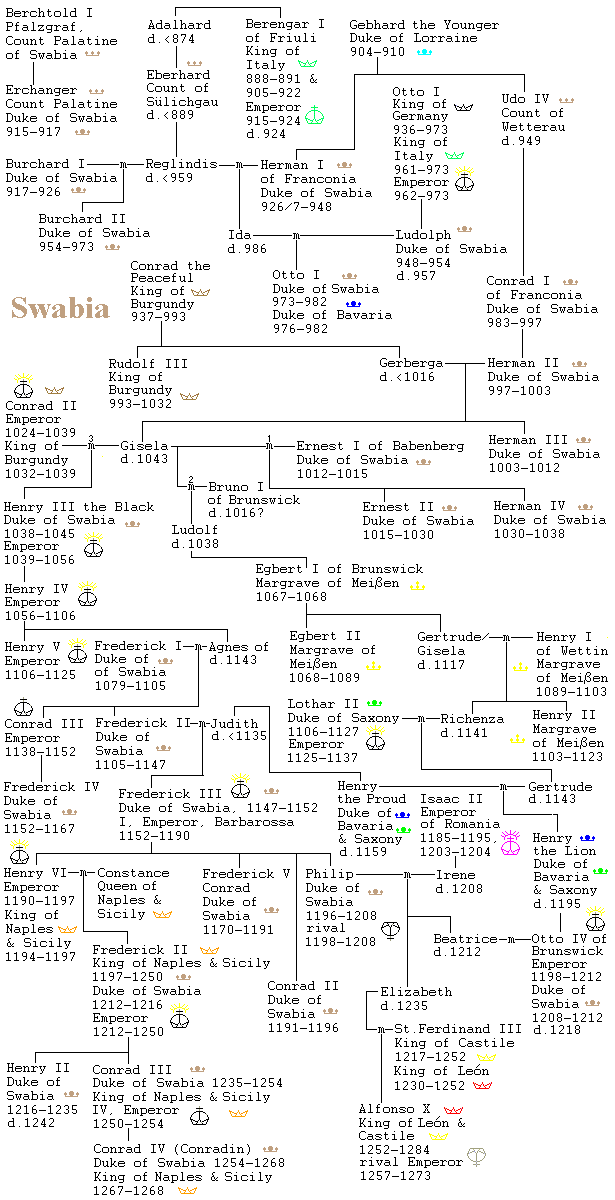
| Dukes of Bavaria | |
|---|---|
| Luitpold | Duke, 889-907 |
| Arnulf the Bad | 907-937 |
| Eberhard | 937-938, d.c.966 |
| Berthold | 938-947 |
| Henry I of Saxony | 948-955 |
| Henry II the Quarrelsome | 955-976, 985-995 |
| Otto I of Swabia | 976-982 |
| Henry III the Younger | 983-985 |
| Henry IV the Saint, II of Germany | 995-1004, 1009-1017 |
 Emperor, Emperor,1002-1024 | |
| Henry V of Luxemburg | 1004-1009, 1018-1026 |
| Henry VI of Franconia | 1027-1042, 1047-1049, d.1056 |
| Henry VII the Black, of Luxemburg III, Emperor | 1042-1047 |
 Emperor, Emperor,1039-1056 | |
| Conrad of Zütphen | 1049-1053, 1054-1055 |
| Henry VIII | 1053-1054, 1077-1095, d.1106 |
| Agnes | 1055-1061, d.1077 |
| Otto II of Northeim | 1061-1070, d.1083 |
| Welf I (IV) | 1070-1077, 1096-1101 |
| Welf II (V) | 1101-1120 |
| Henry IX (III) the Black | 1120-1126 |
| Henry X (IV) the Proud | 1126-1139 |
| Leopold of Babenburg | 1139-1141 |
| Henry XI Jasomirgott | 1143-1156, d.1176 |
| Henry XII (V) the Lion | 1156-1180, d.1195 |
| deposed by Frederick I Barbarossa, 1180 | |
In the final showdown of Henry the Lion of Bavaria and Saxony with the Emperor Frederick I Barbarossa, Frederick is triumphant and deprives Henry of his fiefs. Bavaria is passed on to the Wittelsbachs, who hold it henceforth, actually all the way until 1918.
There seem to be two common systems of numbering for some of the Dukes of Bavaria. The Welf Henry the Lion can be seen given as Henry XII or as Henry V. Since "XII" clearly numbers Dukes of Bavaria, and "V" is not a number from Saxony (where he was only Henry III), it can only be a number from the House of Welf. My genealogy of Welf, however, must be incomplete, since I only find one other Henry above Henry III.
The list has been corrected using the Regentenlisten und Stammtafeln zur Geschichte Europas by Michael F. Feldkamp [Philipp Reclam, Stuttgart, 2002, pp.280-282].
| Dukes, Electors, & Kings of Bavaria; Wittelsbachs | |||
|---|---|---|---|
| Otto I, Count of Wittelsbach | Duke, 1180-1183 | ||
| Louis I the Kelheimer | 1183-1231 | ||
| Count of the Palatinate, 1214 | |||
| Otto II the Noble | 1231-1253 | ||
| Louis II the Severe | 1253-1294 | ||
| Louis IV | 1294-1347 | Rudolf I | 1294-1317, d.1319 |
 Emperor, 1314-1347 | Rudolf II | Count of the Palatinate, 1329-1353 | |
| Stephen II | 1347-1375 | Louis V | 1347-1351, d.1365 |
| Brandenburg 1324-1351 | |||
| Meinhard | 1361-1363 | ||
| Louis VI the Roman | 1347-1365 | ||
| Brandenburg 1351-1365 | |||
| Otto V | 1347-1373 | ||
| Brandenburg 1365-1373 | |||
| John II | 1375-1397 | Frederick | 1375-1393 |
| Ernest | 1397-1438 | Henry XVI the Rich | 1393-1450 |
| William III | 1397-1435 | ||
| Albert III | 1438-1460 | Louis IX the Rich | 1450-1479 |
| John IV | 1460-1463 | ||
| Sigismund | 1460-1467, d.1501 | George the Rich | 1479-1503 |
| Albert IV the Wise | 1465-1508 | ||
| William IV | 1508-1550 | Louis X | 1516-1545 |
| Duchy united, 1545 | |||
| Albert V | 1550-1579 | ||
| William V the Pious | 1579-1597, d.1626 | ||
| Maximilian I | 1597-1651 | ||
| Elector, 1623-1651 | |||
| Ferdinand Maria | 1651-1679 | ||
| Maximilian II Emmanuel | 1679-1726 | ||
| Defeats Turks, captures Belgrade, with Imperial Army in Hungary, 1688; Allied with France in the War of the Spanish Succession, defeated and army destroyed by the Duke of Marlborough and Prince Eugène of Savoy at Blenheim, 1704, lost Bavaria for the duration, until 1714 | |||
| Charles (VII) Albert | 1726-1745 | War of the Austrian Succession, 1740-1748 | |
| Emperor, 1742-1745 | |||
| Maximlian III Joseph | 1745-1777 | ||
| Line passes to Palatinate | |||
| Henry XIII | 1253-1290 |
| Louis III | 1290-1296 |
| Otto III | 1290-1312 |
| King of Hungary, 1305-1307 | |
| Henry XV the Natterberger | 1312-1333 |
| Stephen I | 1290-1309 |
| Otto IV | 1309-1334 |
| Henry XIV the Elder | 1309-1339 |
| John I the Child | 1339-1340 |
| William V | Duke of Zealand 1347-1389 |
| Albert of Holland | Count of Hainault & Holland 1389-1404 |
| Albert II the Younger | 1387-1397 |
| John III | 1404-1429 |
| William IV | 1404-1417 |
| Jacqueline of Holland | 1417-1433 d.1436 |
The third table is that of Stephen III, the Magnificent, brother of John II and Frederick,
| Stephen III the Magnificent | 1375-1413 |
| Louis VII the Bearded | 1413-1443, d.1447 |
| Louis VIII the Younger | 1443-1445 |
It took a long time for primogeniture to be accepted among these German houses, and meanwhile, domains were divided and subdivided, often permanently. Bavaria, however, was preserved by the circumstance that branch lines died out. Ultimately the main Bavarian line of the Wittelsbachs itself died out, and the succession passed to the Wittelsbach Electors of the Palatinate.
Noteworthy here is the career of the Elector Maximilian II, who achieved fame leading Imperial armies against the Turks in the Balkans. His first wife and son were Heirs to the Throne of Spain. After they both died, Maximilian nevertheless decided to adhere to France in the War of the Spanish Succession. He was perhaps hoping that the French would overthrow the Emperor Leopold, who had been his father-in-law, and that Maximilian himself would be elected Emperor -- as his son would be during the War of the Austrian Succession. This all came to nought on the battlefield of Blenheim in 1704, where the French army was destroyed and Maximilian had to lead a perilous retreat of the remaining French left, harried all the way by Marlborough and Eugène. Maximilian was then a refugee with the French for the rest of the War, after which he was restored to his lands. Meanwhile, the Electress Theresa had been allowed to govern Munich, even as the rest of Wittelsbach lands were occupied by Austria.
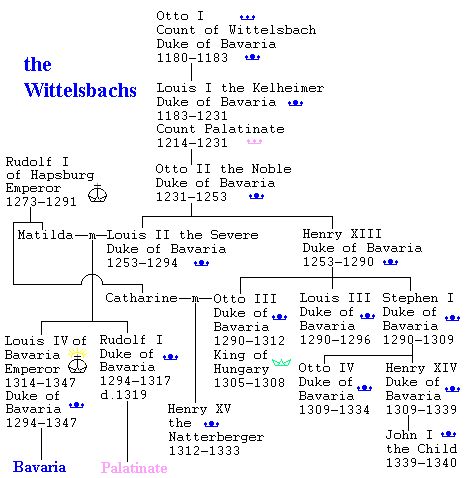
The following table shows the main Bavarian and Dutch lines of the Wittelsbachs. The Palatine line is continued below.
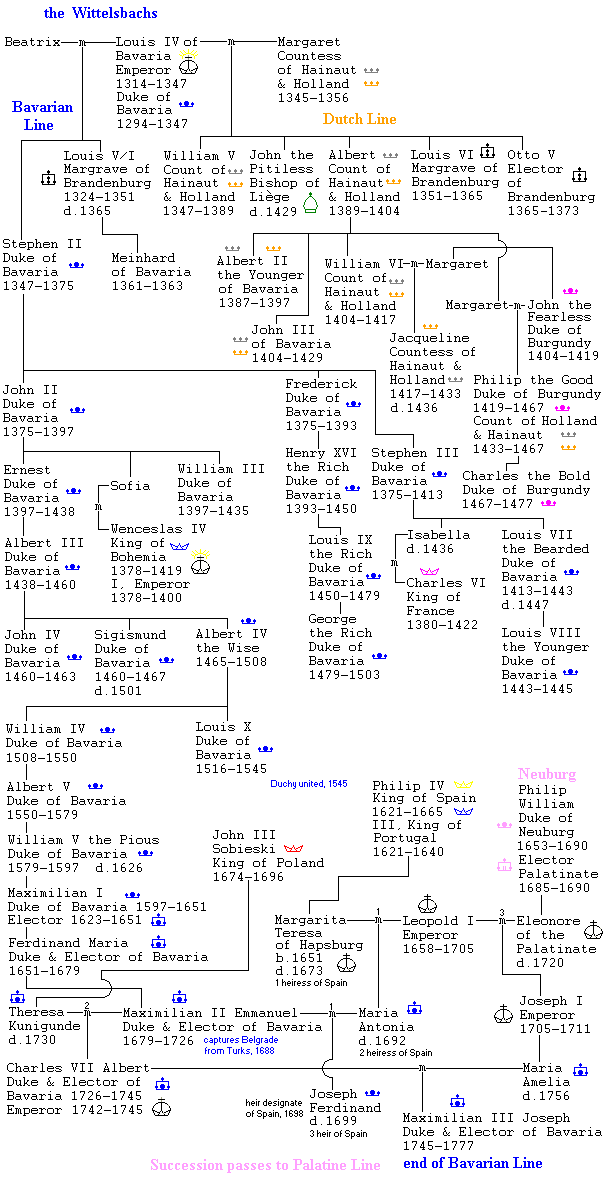
| Counts & Prince Electors of the Palatinate; Wittelsbachs | |
|---|---|
| Rudolf II of Bavaria | 1329-1353 |
| Rupert I | 1353-1390; Prince Elector, 1356 |
| Rupert II | 1390-1398 |
| Rupert III | 1398-1410 |
| Emperor, 1400-1410 | |
| Louis III | 1410-1436 |
| Louis IV the Gentle | 1436-1449 |
| Frederick I the Victorious | 1452-1476 |
| Philip the Upright | 1476-1508 |
| Louis V the Pacific | 1508-1544 |
| Frederick II | 1544-1556 |
| Otto Henry | 1556-1559 |
| Frederick III | 1559-1576 |
| Louis VI | 1576-1583 |
| Frederick IV | 1583-1610 |
| Frederick V the "Winter King" | 1610-1623, d.1632 |
| King of Bohemia, 1619-1620 | |
| Imperial Troops overrun Palatinate, 1622 | |
| Fredrick Henry | Count Palatine d.1629 |
| Peace of Westphalia, Electorate restored, 1648 | |
| Charles I Louis | 1648-1680 |
| Charles II | 1680-1685 |
| Philip William | 1685-1690 |
| John William | 1690-1716 |
| Charles III Philip | 1716-1742 |
| Charles IV Theodore | 1742-1799 |
| Duke of Bavaria, 1777 | |
After all the changing fortunes of the War, however, an Electorship was finally restored to the Palatine at the Peace of Westphalia (1648). But this was not quite the end of the story for Frederick. He had married a daughter, Elizabeth, of King James I of England. One of his daughters, Sophie, married Ernest Augustus, Elector of Hanover. This gave their son, George, a claim to the throne of England. When the British Parliament rejected the surviving Catholic Stuarts, George succeeded to the thrones of England, Scotland, and Ireland (they also said France at the time) as King George I in 1714. This "Hanoveran Succession" then provided the ruling House of Britain until Queen Victoria.
The genealogical tables for all the Wittelsbachs began with Brian Tompsett's Royal and Noble genealogy. This left many gaps, especially in that the descent of the Dukes of Zweibrücken, who succeeded to the Duchy and Electorship of Bavaria in 1799, shortly to become the Kings of Bavaria, was not given. Christopher Haußmann of Munich helped out by informing me that the original Zweibrücken line, missing in Tompsett, led to three Kings and one Queen of Sweden, Charles X, XI, XII and Ulrika. It is after the Swedish Wittelsbachs die out that Christian III becomes the Duke of Zweibrücken. The full genealogy I have found in Die Herzöge in Bayern by Hermann von Witzleben [Prestel-Verlag München, 1976]. A narrative description of the Wittelsbach genealogy can be found here.
The middle of the diagram below is crowded with the descendants of Wolfgang of Zweibrücken. The seniority of his sons is numbered. To the eldest went Neuburg, to the middle, Zweibrücken, and to the youngest, Birkenfeld. Within Neuburg, we then get the junior line of Sulzbach. With the extinction of the line of Electors from Simmern in 1685, the title passes to Neuburg, and then in 1742 to Sulzbach. Meanwhile, the title of Zweibrücken, which itself had passed to (numbered) junior lines in Landsberg and Kleeburg (Kings of Sweden), had passed to Birkenfeld in 1731. When the Sulzbach line ended in 1799, having inherited Bavaria itself in 1777, it all passed to Birkenfeld-Zweibrücken.
Needless to say, the family tragedy of dying cousins served to consolidate the Wittelsbach holdings and prevented the kind of fragmentation seen in the Saxon Duchies. The cramped part of this diagram, drawn for a screen 640 pixels wide (the diagram itself is only 613), is unfolded for a screen 1024 pixels wide (the diagram itself is 995) here. The lines of succession are numbered in sequence in that diagram, with cues given for transfers, and some present day descendants of King Ludwig III are shown -- especially noteworthy is the marriage of the Duchess Sophie to Aloys the Heir of Liechtenstein.
| Dukes, Electors, & Kings of Bavaria; Wittelsbachs | |||
|---|---|---|---|
| Charles Theodore of the Palatinate | 1777-1799 | War of the Bavarian Succession, 1778-1779 | |
| Maximilian IV/ I Joseph of Palatinate-Zweibrücken | Elector, 1799-1805 | ||
| King, 1805-1825 | |||
| Ludwig I | 1825-1848, d.1868 | ||
| Maximilian II Joseph | 1848-1864 | brother of Otto, King of Greece, 1832 | |
| Ludwig II the Mad | 1864-1886 | German Empire, 1871 | |
| Otto | 1886-1913 | Luitpold | Regent, 1886-1912 |
| Ludwig III | Regent, 1912-1913 | ||
| 1913-1918, d.1921 | |||
Bavaria became a Kingdom as an ally of Napoleon, but unlike other such German allies, it gained rather than lost land at the Congress of Vienna. This made it the largest state in Germany after Austria and Prussia.
 The blue and white of Bavaria is now internationally familiar from the crest of BMW (Bavarian Motor Works) automobiles -- popularly known as "Beamers." BMW now also owns the MINI motor company of Britain, maker of the fetching Mini Cooper automobiles.
The blue and white of Bavaria is now internationally familiar from the crest of BMW (Bavarian Motor Works) automobiles -- popularly known as "Beamers." BMW now also owns the MINI motor company of Britain, maker of the fetching Mini Cooper automobiles.
A fifth cousin of King Maximilian II was the Empress Elizabeth of Austria, popularly known as "Sisi" in Vienna, even though she didn't like Vienna and spent little of her later years there. Assassinated by an anarchist, and after her son, the Archduke Rudolf, the Heir of the Hapsburgs, had committed suicide, she is consequently regarded as a tragic and romantic figure. Her apartments in the Hofburg Palace are kept as a museum. Rudolf, however, had a daughter, Elizabeth, who has many, many descendants, as we see in the genealogy. None of these are Wittelsbachs or Hapsburgs, and so they have largely dropped off the radar. But they are out there.
Meanwhile, the last King of Bavaria, Ludwig III, also has many descendants. They are not only the heirs of the Wittelsbachs but also the heirs of the Scottish House of Stuart, and now include the Heirs of the Principality of Liechtenstein. This is not off the radar, especially when anyone is curious about who would be the Stuart Pretender to the Throne of England and Scotland. After so many Wittelsbach lines died out, it is good to see some revival of fertility among the heirs.
The present Head of the House of Wittelsbach, Franz (b.1933), actually spent time in Nazi concentration camps, including Dachau, after his family was arrested when the Germans occupied Hungary in 1944. The family had been, after all, anti-Nazi. Franz is also the present Heir of Stuart. The Stuart Succession, but not the Wittelsbach, will pass to his niece Sophie, who is married to the Regent of Liechtenstein. The Wittelsbach Succession, following the Salic Law, will pass from Sophie's father, Max, to his cousin Luitpold (b.1961).

The suicide of the Archduke Rudolf and the apparent depression of the Empress Elizabeth, perhaps not all due to grief and mourning, makes us wonder about the mental health of the later Wittelsbachs. We wonder again at the story of King Ludwig (II) "the Mad" of Bavaria, who built fairy-tale castles, like the famous Neuschwanstein (at right), promoted musicians, like Richard Wagner, supposedly had an affair with the sculptress, and future Texan, Elizabet Ney, and killed himself (or was murdered?) after being declared insane and deposed in 1886. A lot of this may also leave us wondering how "mad" was he? What all else was going on here?
| Dukes of Carinthia | |
|---|---|
| Henry I of Bavaria | 976-978, 983-989 |
| Otto of Worms | 978-983, 995-1004 |
| Henry II | 989-995 |
| Conrad I | 1004-1011 |
| Adalbert I of Eppstein | 1012-1035, d.1039 |
| Conrad II | 1036-1039 |
 Henry I the Black, Henry I the Black,III of Germany | 1039-1047 |
| Swabia, 1038-1045 | |
| Franconia, 1039-1056 | |
| Bavaria, 1042-1047 | |
| Emperor, 1039-1056 | |
| Welf (III) | 1047-1055 |
| Conrad III of Ezzone | 1056-1061 |
| Berthold I of Zähringen | 1061-1077, d.1078 |
| Liutold of Eppstein | 1077-1090 |
| Henry III | 1090-1122 |
| Henry IV of Sponheim | 1122-1123 |
| Engelbert | 1124-1135, d.1141 |
| Ulrich I | 1135-1144 |
| Henry V | 1144-1161 |
| Hermann | 1161-1181 |
| Ulrich II | 1181-1202 |
| Bernhard | 1202-1269 |
| Ottokar II the Great | King of Bohemia, 1253-1278 |
| 1269-1276 | |
| Rudolf of Hapsburg | Emperor, 1273-1291 |
| 1276-1286 | |
| Duke of Austria, 1278-1282 | |
| Meinhard of Görz-Tirol | 1286-1295 |
| Henry VI | 1295-1335 |
| to Hapsburgs, 1335 | |

From Imperial politics, we begin to pass into local politics, with rule by the Houses of Eppstein, Sponheim, and Görz-Tirol. Indeed, this approaches the period when Germany begins to fragment beyond hope. But Imperial politics returns to this area. The struggle of Ottokar of Bohemia with Rudolf of Hapsburg, which decided the fate of nearby Austria, would now decide the fate of Carinthia also. After a brief return to local rule, the Duchy becomes permanently attached to Austria, as indeed it still is, even after the passing of the Hapsburgs.
| Margraves & Dukes of Austria | |
|---|---|
| Babenbergs | |
| Leopold I | Margrave, 976-994 |
| Henry I | 994-1018 |
| Adalbert | 1018-1055 |
| Ernst | 1055-1075 |
| Leopold II | 1075-1096 |
| Leopold III, the Pious | 1096-1136 |
| Leopold IV | 1136-1141 |
| Henry II | 1141-1156 |
| Duke, 1156-1177 | |
| Leopold V the Virtuous | 1177-1194 |
| Third Crusade, 1189-1192 | |
| Frederick I | 1194-1198 |
| Leopold VI, the Glorious | 1198-1230 |
| Frederick II, the Fighter | 1230-1246 |
| Herman of Baden | 1248-1250 |
| Ottokar II, of Bohemia | 1253-1276 |
| King of Bohemia, 1253-1278 | |
 The flag of Austria is supposed to have originated on the Third Crusade. At the siege of Acre (whose Classical name, Ptolemais, Πτολεμαΐς, is also sometimes seen) in 1191, the tunic of Duke Leopold V (whose mother was Theodora Comnena) was completely covered with blood, except for a white band where his belt had covered it. Raising his shirt as a standard during the fight, he was offically granted the use of the colors by the Emperor Henry VI. Conducting the siege at Acre was King Richard I of England. Richard insulted Leopold by removing his colors from Acre after its fall. Leopold then kidnapped him on his way home and held him for ransom in Austria. This became a matter for English romance when Richard's delayed return allowed his brother John to exercise enough misrule to provoke the resistance of people like Robin Hood. Unfortunately, when Richard did return, he soon died, and John's misrule soon provoked even the nobility, who at Runnymede forced him to sign the Magna Carta. While holding Richard, Leopold freed hostages that Richard had taken while seizing Cyprus, this included the colorful "Damsel of Cyprus."
The flag of Austria is supposed to have originated on the Third Crusade. At the siege of Acre (whose Classical name, Ptolemais, Πτολεμαΐς, is also sometimes seen) in 1191, the tunic of Duke Leopold V (whose mother was Theodora Comnena) was completely covered with blood, except for a white band where his belt had covered it. Raising his shirt as a standard during the fight, he was offically granted the use of the colors by the Emperor Henry VI. Conducting the siege at Acre was King Richard I of England. Richard insulted Leopold by removing his colors from Acre after its fall. Leopold then kidnapped him on his way home and held him for ransom in Austria. This became a matter for English romance when Richard's delayed return allowed his brother John to exercise enough misrule to provoke the resistance of people like Robin Hood. Unfortunately, when Richard did return, he soon died, and John's misrule soon provoked even the nobility, who at Runnymede forced him to sign the Magna Carta. While holding Richard, Leopold freed hostages that Richard had taken while seizing Cyprus, this included the colorful "Damsel of Cyprus."

Putting together the story of the Hapsburgs ("Habsburg" in German, which is becoming more common in English) has been a daunting task. The tables and genealogies here are now increasingly based on the Erzählende genealogische Stammtafeln zur europäischen Geschichte, Volume I, Part 1, Deutsche Kaiser-, Königs-, Herzogs- und Grafenhäuser I [Andreas Thiele, Third Edition, R. G. Fischer Verlag, 1997]. Initially I relied on more readily available sources in English. Two books specifically about the Hapsburgs that I had, The House of Habsburg by Adam Wandruszka [Doubleday Anchor, 1965] and The Habsburgs, Embodying Empire by Andrew Wheatcroft [Viking, 1995], were not bad, but incomplete; and the Kingdoms of Europe by Gene Gurney [Crown Publishers, New York, 1982] had full lists of Hapsburgs. Wandruszka had better genealogies (Gurney, none). One problem is sorting out who was ruling what and when, since Austrian possessions where passed out to the many sons of the usually large Hapsburg families. Until 1379 this did not imply any real division of the possessions. Then we have a real division between the sons of Albert II, namely Albert III (the Albertine line) and Leopold III (the Leopoldine line). A further Tyrolean branch of the Leopoldine line began with Frederick IV, son of Leopold, in 1406, as follows.

The genealogy at right traces back the earliest Hapsburgs. That this goes all the way to Louis the Pious may be a little suspicious, but there may only be one link that is really questionable. Nevertheless, this all passes through very obscure people in a very obscure period. But it is possible. If true, it makes the Hapsburgs cousins of the Free Counts of Burgundy, derived from the great Count Otto William. Habsburg itself was a castle in the Aargau, founded by Count Radbot, a name that curiously never occurs again in the Hapsburg line. Aargau and Thurgau are now both Cantons of Switzerland. The Hapsburgs got tossed out, which is a tribute to the heroism and independent spirit of the Swiss. But it may have also been that the Hapsburgs had bigger fish to fry. The Emperor Maximilian, who recognized Swiss autonomy in 1499, was already juggling Austria, Germany, the Netherlands, Burgundy, and Spain, all of which may have seemed worth the sacrifice.
The numbering of the names cannot be accounted for without listing all the Alberts, Rudolfs, Ottos, Fredericks, and Leopolds, some of whom figure in junior lines or who died young and who cannot be considered to have discharged serious responsibilities of rule (and the numbers all restart from I after the acquisition of Austria). In the table below, these figures are listed with light background and death date only. Even for the important members of the dynasty, however, what and when they ruled was not given by either Wandruszka or Wheatcroft. Gurney's list sometimes raised questions that it does not answer. For instance, Frederick V and his brother Albert VI succeeded to rule at the death of their father, Ernst the Iron Duke, in 1424 (according to Thiele, Gurney, & Wandruszka; Wheatcroft had 1427); but Gurney only lists their rule from 1457, when the death of their young cousin Ladislas ended the Albertine line and reunified the Austrian domain (except for the Tyrol). Frederick had already been crowned Emperor by then -- the only Hapsburg crowned in Rome by the Pope. Things like this get cleared up by Thiele: In 1424 Frederick was only 9 and Albert only 6 years old. Frederick began to rule in 1436, Albert in 1439/40.
| Hapsburgs/Habsburgs of Austria | |||
|---|---|---|---|
| Rudolf IV (I of Austria & Empire) | Count of Hapsburg, 1239 | Emperor, 1273-1291 | |
| Duke of Austria, 1278-1282 | |||
| Albert I | 1282-1308 | Rudolf II | d.1290 |
| Emperor, 1298-1308 | John the Parricide | d.1313 | |
| Frederick I, the Handsome | 1308-1330 | Rudolf III | King of Bohemia, 1306-1307 |
| Rival Emperor, 1325-1330 | Leopold I | coregent, 1308-1326 | |
| Defeated by Swiss, Morgarten, 1315 | |||
| Albert II | 1330-1358 | Otto | coregent, 1330-1339 |
| Frederick II | d.1344 | Leopold II | d.1344 |
| Rudolf IV | 1358-1365 | Frederick III | d.1362 |
| Albertine Line: Upper & Lower Austria, 1379 | Leopoldine Line: Styria, Carinthia, Carniola, & Tryol, 1379 | ||
| Albert III Long Hair | 1358-1395 | Leopold III | 1365-1386 |
| Battle of Sempach, Leopold killed in defeat by Swiss, 1386 | |||
| Albert IV | 1397-1404 | William | 1386-1406 |
| Albert V (II of Empire) | 1404-1439 | Leopold IV the Proud | 1386-1411 |
| King of Bohemia & Hungary, 1437-1439 | Ernst the Iron Duke | 1406-1424 | |
| Swiss conquer Hapsburg Aargau, 1415 | |||
| Emperor, 1438-1439 | Leopoldine Line: Austria, 1457 | ||
| Ladislas Postumus | 1440-1457 | Albert VI | 1424-1463 |
| King of Bohemia, 1439-1457; King of Hungary, 1444-1457 | 1457-1463 | ||
| Albertine Line ends, 1457 | |||
| Frederick V (III of Empire) | 1424-1493 | ||
 Emperor, Emperor,1440-1493 | |||
| Archduke, 1457-1493 | |||
| Archdukes continue as Holy Roman Emperors | |||
| Leopoldine Line: Tyrol, 1406 | |
|---|---|
| Frederick IV the Empty | 1406-1439 |
| Sigmund | 1439-1490, d. 1496 |
Genealogical diagrams for the Hapsburgs beginning with the Duke/Emperor Rudolf I can be found with the German Emperors and with the Kings of Spain. The Imperial diagram also includes all the Kings of Spain and many of the intermarriages between the lines, which produced several grotesque features, like the "Hapsburg Lip." The details of the genealogy in the table at left, which covers the period before the era of Hapsburg predominance in Europe, is show below
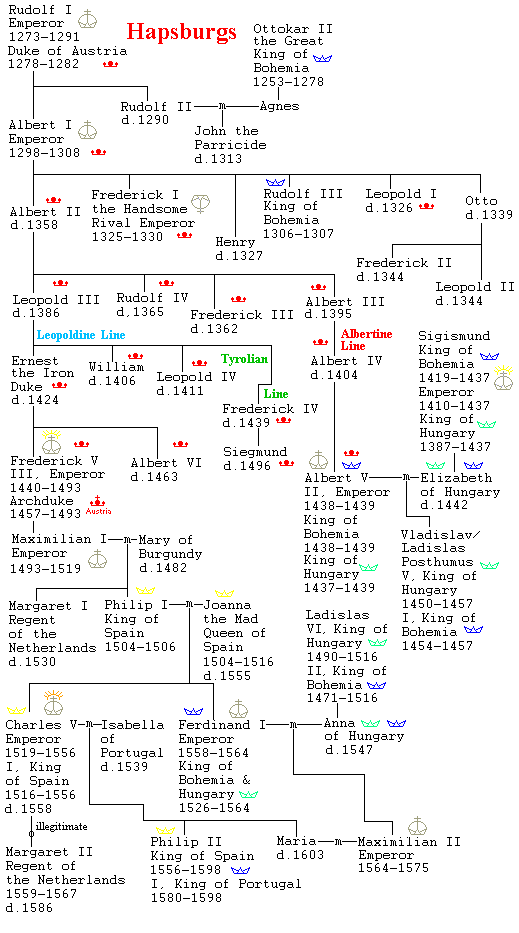 This genealogy is entirely from the Erzählende genealogische Stammtafeln zur europäischen Geschichte, Volume I, Part 1, Deutsche Kaiser-, Königs-, Herzogs- und Grafenhäuser I [Andreas Thiele, Third Edition, R. G. Fischer Verlag, 1997]. More genealogical information can be found, not just under the Empire and Spain, linked above, but also under Burgundy, which the Emperor Maximillian acquired, and Hungary and Bohemia, where the Hapsburgs often intermarried and which the Emperor Ferdinand I acquired. Note that neither Charles nor Ferdinand are traditional Hapsburg names -- the former is Burgundian and the latter Spanish. Maximilian is not a traditional Hapsburg name either, but it doesn't seem to have any historical precedent, unless it is Rome.
This genealogy is entirely from the Erzählende genealogische Stammtafeln zur europäischen Geschichte, Volume I, Part 1, Deutsche Kaiser-, Königs-, Herzogs- und Grafenhäuser I [Andreas Thiele, Third Edition, R. G. Fischer Verlag, 1997]. More genealogical information can be found, not just under the Empire and Spain, linked above, but also under Burgundy, which the Emperor Maximillian acquired, and Hungary and Bohemia, where the Hapsburgs often intermarried and which the Emperor Ferdinand I acquired. Note that neither Charles nor Ferdinand are traditional Hapsburg names -- the former is Burgundian and the latter Spanish. Maximilian is not a traditional Hapsburg name either, but it doesn't seem to have any historical precedent, unless it is Rome.
| Margraves & Electors of Brandenburg | |
|---|---|
| North March/Mark, 936 | |
| Sigfried | Margrave, 936-937 |
| Gero | 936-965 |
| Dietrich of Haldensleben | 965-985 |
| Thietmar of Schwabengau | 965-978 |
| Hodo | 978-993, d.1015 |
| Lothar of Walbeck | 993-1003 |
| Werner | 1003-1009 |
| Bernard I of Haldensleben | 1009-1018 |
| Bernard II | 1018-c.1045 |
| William | 1045-1056 |
| Lothar Udo I of Stade | 1056-1057 |
| Lothar Udo II | 1057-1082 |
| Henry | 1082-1087 |
| Lothar Udo III | 1087-1106 |
| Rudolph | 1106-1114 |
| Henry II | 1114-1128 |
| Lothar Udo IV | 1128-1130 |
| Conrad I Plötzkau | 1130-1133 |
| Ascanians | |
| Albert I the Bear | 1134-1170 |
| Saxony, 1138-1142 | |
| Brandenburg, 1136 | |
| Otto I | 1170-1184 |
| Otto II | 1184-1205 |
| Albert II | 1205-1220 |
| Otto III | 1220-1267 |
| John I | 1220-1266 |
| Otto IV | 1266-1309 |
| John II | 1266-1281 |
| Conrad II | 1266-1304 |
| Waldemar the Great | 1309-1319 |
| Wittelsbachs | |
| Louis I, V of Bavaria | 1324-1351, d.1361 |
| Louis II (VI) | 1351-1365 |
| Elector, 1356-1365 | |
| Otto (V) | 1365-1373 |
| Luxemburg | |
| Charles | 1373-1378 |
 Emperor, Emperor,1347- 1378 | |
| Wenceslaus | 1373-1378, d.1419 |
 Emperor, Emperor,1378- 1400 | |
| Sigismund | 1378-1397, 1411-1417, d.1438 |
 Emperor, Emperor,1410- 1437 | |
| Jobst | 1397-1411 |

For a century, from 1319 to 1417, Brandenburg becomes an Imperial holding, for the families of both the Wittelsbach and Luxemburg Emperors, before the Emperor Sigismund fatefully bestows it on the Hohenzollerns. Early in this period it becomes one of the permanent Electorates of the Empire under the Golden Bull of 1356.
The genealogy here is entirely form the Erzählende genealogische Stammtafeln zur europäischen Geschichte, Volume I, Part 1, Deutsche Kaiser-, Königs-, Herzogs- und Grafenhäuser I [Andreas Thiele, Third Edition, R. G. Fischer Verlag, 1997]. The table was originally from some other sources, and the first Margrave, Sigfried, does not appear in Thiele.
| Margraves & Electors of Brandenburg, Kings of Prussia, & Emperors of Germany; Hohenzollerns | |
|---|---|
| Frederick I | 1417-1440 |
| Frederick II, "Iron Tooth" | 1440-1470 |
| Albert Achilles | 1470-1486 |
| John Cicero | 1486-1499 |
| Joachim I | 1499-1535 |
| Joachim II | 1535-1571 |
| John George | 1571-1598 |
| Joachim Frederick | 1598-1608 |
| John Sigismund | 1608-1619 |
| Duke of Prussia, 1618-1619 | |
converts to Calvinism, 1613; partition of the Jülich-Cleve  domains, Treaty of Xanten, 1614; inherits the Duchy of Prussia, secularized from the Teutonic Knights in 1525, 1618 domains, Treaty of Xanten, 1614; inherits the Duchy of Prussia, secularized from the Teutonic Knights in 1525, 1618 | |
| George William | 1619-1640 |
| Frederick William, The Great Elector | 1640-1688 |
| Peace of Westphalia, 1648; Poles defeated at Warsaw, 1656; sovereignty in Prussia recognized by Sweden, 1656, by Poland, 1657; Swedes defeated and annihilated at Fehrbellin, 1675 | |
| Frederick III / Frederick I of Prussia | 1688-1713 |
| King of Prussia 1701-1713 | |

Although Brandenburg had been one of the major German states for some time, major enough to rate an Electoral Vote, it is hard to imagine it growing into a Great Power without the additions that began to accrue during the reign of John Sigismund. Inherited territories in the Rhine Valley (in the dispute over the Jülich-Cleve Succession), and the Duchy of Prussia, not only gave the state anchors in both east and west, but brought the domain that would soon give its name, Prussia, to the whole -- and become a byword for military strength and ruthless conquest.
Yet for a long time the postion of Brandenburg was precarious. Landlocked, with no natural frontiers, and no easy means of communication across the central lands, let alone to the outlying domains in east and west, Brandenburg was vulnerable to any insult. Its postion was completely hopeless during the Thirty Years War, when half its population was lost through starvation, massacre, and flight. The lurid stories of atrocities in the War, although so extreme as to engender some scepticism, nevertheless appear to be generally true, thanks to multiple contemporary testaments, often from participants.
From this nadir, Brandenburg set out on the path to becoming a Power thanks to the wisdom and industry of The Great Elector, Frederick William. By diplomacy, internal reforms, and prudent military measures, the Elector obtained favorable additions to Brandenburg from the Peace of Westphalia in 1648, secured recognition of independence and sovereignty in Prussia from Sweden (which had designs) and from Poland (which had been suzerain since the days of the Teutonic Knights), and finally created a European sensation by destroyed a superior invading Swedish army at Fehrbellin in 1675.

Sovereignty in Prussia not only elevated the status of Brandenburg on the European stage, but it also contributed to Frederick William's efforts to overcome the remnants of local Mediaeval paricularism and autonomy in his possessions. For example, the Rhenish possessions sometimes relied on the Dutch to resist the Elector; and the Estates of Prussia had even retained the right of appeal to the King of Poland to foil Electoral initiatives. After Frederick William and the Swedes defeated the Poles at Warsaw in 1656, his authority in Prussia was secured; but then, after the Polish speaking Elector actually became an ally of Poland in 1658, Brandenburger arms would be historically vindicated at Fehrbellin. Many retreating and even surrendering Swedes were killed by local peasants who still had fresh memories of the atrocities of the Thirty Years War.
 Until 1701 no German states were kingdoms. Then Frederick III asked a favor of the Emperor Leopold I as a condition of entering the War of the Spanish Succession -- a royal crown. This was granted, but Frederick didn't want to assume it for a domain under the jurisdiction of the Emperor, so he chose to use it for Prussia, which was outside the Empire. On the other hand, there seems to have been some scruple about turning Prussia itself into a Kingdom, so at first the locution "King in Prussia" was used to leave things a little vague, which occasioned a bit of amusement in Europe. Soon the subtlety was forgotten; and all the lands of Brandenburg began to be absorbed into the identity of a Baltic people who had actually disappeared under the conquest of the Teutonic Knights. The Knights themselves now contribute their colors, black and white, to Prussia and, later, Imperial Germany. Meanwhile, the Pope protested, without effect, that a Catholic monarch had granted a royal title without Papal consent. The Hapsburgs would regret the act themselves, but it could not be undone. Prussia as Prussia had arrived; and a paradoxical Kingdom within the erstwhile Kingdom of the Eastern Franks would simply add to the incoherence of the obsolescent Empire.
Until 1701 no German states were kingdoms. Then Frederick III asked a favor of the Emperor Leopold I as a condition of entering the War of the Spanish Succession -- a royal crown. This was granted, but Frederick didn't want to assume it for a domain under the jurisdiction of the Emperor, so he chose to use it for Prussia, which was outside the Empire. On the other hand, there seems to have been some scruple about turning Prussia itself into a Kingdom, so at first the locution "King in Prussia" was used to leave things a little vague, which occasioned a bit of amusement in Europe. Soon the subtlety was forgotten; and all the lands of Brandenburg began to be absorbed into the identity of a Baltic people who had actually disappeared under the conquest of the Teutonic Knights. The Knights themselves now contribute their colors, black and white, to Prussia and, later, Imperial Germany. Meanwhile, the Pope protested, without effect, that a Catholic monarch had granted a royal title without Papal consent. The Hapsburgs would regret the act themselves, but it could not be undone. Prussia as Prussia had arrived; and a paradoxical Kingdom within the erstwhile Kingdom of the Eastern Franks would simply add to the incoherence of the obsolescent Empire.
On the genealogy above, we see the "elder" lines of Bayreuth and Ansbach. The "younger" lines, which descend from the Elector John George, can be examined on a popup. It is noteworthy that two marriages of Brandenburg-Ansbach led to subsequent Kings of Sweden and of England.
| Frederick William I | 1713-1740 |
| Protestants discovered in Alpine valleys of Salzburg, 1731; their Exodus to Prussia, 1732 | |
|---|---|
| Frederick II the Great | 1740-1786 |
| War of the Austrian Succession, 1740-1748 (First Silesian War, 1740-1742, Second, 1744-1745); Seven Years (Third Silesian) War, 1756-1763 | |
| Frederick William II | 1786-1797 |
| Frederick William III | 1797-1840 |
| Frederick William IV | 1840-1861 |
| Wilhelm I | 1861-1888 |
| Emperor of Germany, 1871-1888 | |
Frederick used, even exhausted, the army first to seize Silesia from Austria in the War of the Austrian Succession, 1740-1748. After writing a book attacking the Realpolitik of Machiavelli, Frederick's practice came to look like the most cynical, opportunistic, and self-serving application of Machiavelli's advice. Since Frederick abandoned his allies in the middle of the War, this further Machiavellian move results in the larger War being divided in half, into the First Silesian War (1740-1742) and the Second (1744-1745).
Frederick then really needed his father's army to defend against the nearly universal alliance (France, Sweden, Russia, & Austria) that Maria Theresa prepared against him to retrieve Silesia in the Seven Years War, 1756-1763. If not for his profound military genius, and a bit of luck, Frederick would not have gotten away with it. 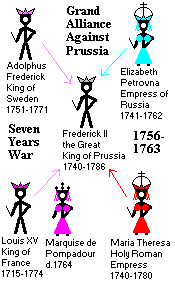 Maria Theresa, while giving Frederick a very bad time, was unable to restore Silesia to Austria. His alliance with Britain during the War earned him the tribute of "King of Prussia," Pennsylvania -- a name that fortunately survived the anti-German name changes of World War I. Silesia, which Bohemia had originally acquired from Poland, ended up returned to Poland after World War II.
Maria Theresa, while giving Frederick a very bad time, was unable to restore Silesia to Austria. His alliance with Britain during the War earned him the tribute of "King of Prussia," Pennsylvania -- a name that fortunately survived the anti-German name changes of World War I. Silesia, which Bohemia had originally acquired from Poland, ended up returned to Poland after World War II.
In the last years of his long reign, der alte Fritz ("Old Fritz") was more than happy to avoid war and instead entertain Enlightenment philosophes. Frederick probably never met Immanuel Kant in Königsberg, but Kant dedicated the Critique of Pure Reason (1781) to his Minister of State, Baron von Zedlitz. Frederick became the archetype of the "enlightened despot," whose characteristic principle is supposed to have been, "You can say whatever you like, but you will do what I tell you." This did not stop him, however, from initiating the partition of Poland. Frederick obtained West Prussia in 1772, as seen on the map above. Subsequent partitions, in 1793 and 1795, were in part to preclude Polish enthusiasm for the French Revolution. At the Congress of Vienna in 1815, the partition of 1795 and much of that of 1793 were ceded to Russia.
Prussia stepped up from the ranks of a Great Power to a Predominant Power thanks to Otto von Bismarck. The Franco-Prussian War (1870-1871) inflicting a crushing and humiliated defeat on France, ended the reign of the Emperor Napoleon III, and then provided the leverage for the unification of Germany into a new German Empire headed by Prussia itself. Wilhelm I, without even a nod to the Pope or the Catholicism of earlier Empires in Francia, turned memories of the Holy Roman Empire into a new German Empire, the "Second," far more unified and stronger than anything had been in the area for centuries. The genealogy for the Emperors is given here, but the table and historical commentary are continued on the Francia page.
In the genealogy here, however, we see some of the family after the fall of the German Empire. Ironically, the Hohenzollern, so responsible for the fall of the Russian Empire, have now intermarried with the heirs of the Romanovs. The present heiress of Romanov, the Grand Duchess Maria, is now the mother of a Hohenzollern heir of Russia itself. Well, Russians might have at least entertained the notion of the Grand Duke Vladimir, or Maria, as a constitutional monarch for the new Russia, but a Hohenzollern would probably be out of the question.
Additional genealogy of the Hohenzollern family can be seen under The Descent of the Hohenzollern and Counts & Princes of Hohenzollern Henchingen-Sigmaringen.
Hohenzollern Emperors of German "Second Reich"
| Princes, Dukes, & Grand Dukes of Mecklenburg | |||
|---|---|---|---|
| Nicholas I | 1130-1160 | ||
| Pribeslaw | 1160-1170 | ||
| Prince, 1170-1178 | |||
| Henry Borwin I | 1178-1219, d.1228 | ||
| Henry Borwin II | 1219-1226 | ||
| Nicholas II | 1219-1225 | ||
| John I the Theologian | 1226-1264 | ||
| Henry I Jerusalem-Farer | 1264-1275, 1298-1302 | ||
| John II | 1275-1299 | ||
| Henry II the Lion | 1287-1329 | ||
| John III | Wismar 1287-1289 | ||
| Albert I the Great | 1329-1348 | ||
| Duke, 1348-1379 | |||
| John IV | 1329-1352 | ||
| Mecklenburg- Stargard, 1352-1377 | |||
| Mecklenburg-Schwerin | |||
| Albert II | King of Sweden, 1365-1388 | ||
| 1379-1412 | |||
| Magnus I | 1379-1385 | ||
| Henry III | 1379-1383 | ||
| Albert III | 1383-1388 | ||
| John IV | 1385-1390, d.1422 | ||
| John II of Mecklenburg-Stargard | 1390-1417 | ||
| Albert IV | 1417-1423 | ||
| John V | 1423-1442 | ||
| Henry IV the Fat | 1423-1477 | ||
| Albert V | 1464-1483 | ||
| John VI | 1464-1474 | ||
| Magnus II | 1477-1503 | ||
| Henry V the Peaceful | Schwerin 1503-1552 | ||
| Albert VI the Handsome | Gustrow 1503-1547 | ||
| John Albert I | 1547-1576 | ||
| John VII | 1576-1592 | ||
| Sigismund Augustus | 1576-1603 | ||
| Adolph Frederick I | 1592-1628, d.1658 | ||
| John Albert II | 1592-1610, 1631-1658 | ||
| Albrecht von Wallenstein | 1628-1631, d.1634 | ||
| Frederick I | Grabow 1658-1688 | Adolph Frederick II | Strelitz 1658-1708 |
| Frederick William | Schwerin 1688-1713 | Adolph Frederick III | 1708-1752 |
| Charles Leopold | 1713-1747 | ||
| Christian Louis | 1747-1756 | ||
| Frederick II | 1756-1785 | Adolph Frederick IV | 1752-1794 |
| Frederick Francis I | 1785-1815 | Charles | 1794-1816 |
| Grand Duke, 1815-1837 | George | 1816-1860 | |
| Paul Frederick | 1837-1842 | ||
| Frederick Francis II | 1842-1883 | Frederick William | 1860-1904 |
| Frederick Francis III | 1883-1897 | ||
| Frederick Francis IV | 1897-1918 | Adolph Frederick V | 1904-1914 |
| Adolph Frederick VI | 1914-1918 | ||
 One might conclude, then, that however great German colonization was, it overwhelmed the local population culturally, but not demographically or politically.
One might conclude, then, that however great German colonization was, it overwhelmed the local population culturally, but not demographically or politically.
The second point is what happened during the Thirty Years War. An Imperial army under the great general, Albrecht von Wallenstein, after the Imperial victory at Lutter (1626), invaded Northern Germany and cleared Protestant forces out of Mecklenburg. This was disturbing enough to the secular German Electors, that the Emperor Ferdinand II (1619-1637) was threatened with a dispute over the election of the next Hapsburg. He dismissed Wallenstein. Meanwhile, however, France had encouraged (with a subsidy) the Swedish King Gustavus Adolphus (1611-1632) to join the fray, which he did in 1630. Two great victories, at Breitenfeld (1631) and Lützen (1632, against a recalled Wallenstein) changed the balance of power, and got Wallenstein out of Mecklenburg, but Gustavus was actually killed at Lützen. Wallenstein himself was shortly to be assassinated, on orders of the Emperor. The Swedish army was then broken at Nördlingen (1634) by a united Austrian and Spanish army, but the Protestant cause was retrieved by the entry of (Catholic) France into the war (1635).
| Counts & Dukes of Schleswig & Holstein | |
|---|---|
| Godfrey | Count of Holstein 1106-1110 |
| Schauenburg | |
| Adolph I | 1110-1131 |
| Adolph II | 1131-1164 |
| Adolph III | 1164-1225 |
| Adolph IV | 1225-1238 d.1261 |
| Holstein-Kiel | |
| John I | 1238-1263 |
| Adolph V | 1263-1273 |
| Holstein- Segeberg 1273-1308 | |
| John II One-Eye | 1263-1316 d.1321 |
| John III the Mild | 1316-1359 |
| Adolph VII | 1359-1390 |
| Holstein-Rendsburg | |
| Nicholas | 1390-1397 |
| Gerhard VI | Duke of Schleswig 1386-1404 |
| 1397-1404 | |
| Albert | Holstein- Segeberg 1381-1404 |
| 1397-1403 | |
| Henry III | 1404-1427 |
| Adolph VIII | 1427-1459 |
| Gerhard VII | 1427-1433 |
| Oldenburg | |
| Christian I | King of Denmark, 1448-1481 |
| 1459-1481 | |
| John I | Denmark, 1481-1513 |
| 1481-1513 | |
| Christian II | Denmark, 1513-1523 |
| 1513-1546, d.1559 | |
| Christian III | Denmark, 1533-1559 |
| 1546-1559 | |
| John III | 1559-1622 |
| Schleswig-Holstein-Sonderburg | |
| Alexander | 1622-1627 |
| Schleswig-Holstein-Beck | |
| Augustus Philip | 1627-1675 |
| Augustus | 1675-1689 |
| Frederick William I | 1689-1719 |
| Frederick Louis | 1719-1728 |
| Frederick William II | 1728-1749 |
| Frederick | 1749-1757 |
| Charles Louis Frederick | 1757-1774 |
| Peter Augustus Frederick | 1774-1775 |
| Charles Frederick Augustus Louis | 1775-1816 |
| Schleswig-Holstein- Sonderburg-Glücksburg, 1825 | |
| Frederick William Paul Leopold | 1816-1831 |
| Charles | 1831-1863, d.1878 |
| to Prussia & Austria, 1864; to Prussia, 1866 | |
Here the lines of Holstein-Sonderburg, Holstein-Beck, and Holstein-Augustenburg are followed, since Holstein-Beck ends up inheriting the Throne of Denmark, while Augustenburg furnished the Prussian candidate for Schleswig-Holstein in 1863. The line of Holstein-Gottorp is examined here and also below under Oldenburg.
The table here was originally put together using Brian Tompsett's Royal and Noble Genealogy and Bruce R. Gordon's Regnal Chronologies. This left many genealogical questions unanswered. Gordon's last Duke, Charles, is not given by Tompsett. Nor did I know from their pages who was the Duke Christian of Augustenburg (and his son, Frederick), upon whose claims the German case was made against the incorporation of the Duchies into the Danish Crown.
Now, however, I have found very complete information in the Erzählende genealogische Stammtafeln zur europäischen Geschichte, Volume II, Part 2, Europäische Kaiser-, Königs-, und Fürstenhäuser II, Nord-, Ost- und Südeuropa [Andreas Thiele, Second Edition, R. G. Fischer Verlag, 1997]. The information is so complete, indeed, that it will be some time before it can all be organized, or that it could ever all be presented in digestible form. The genealogy below, therefore, begins with the Duke Nicholas of Holstein-Rendsburg. Eventually, the earlier Schauenburg line, at least, can all be given. Even the Stammtafeln, however, do not have maps, so the territorial forms of the divisions and subdivisions of the Duchies must remain mysterious for the time being.
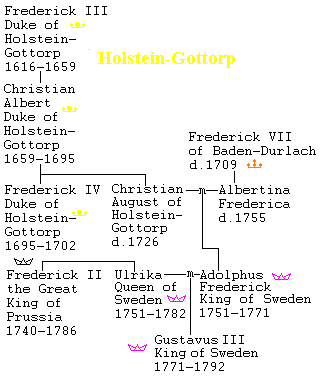
The succession to the Throne of Sweden jumps around a lot. The demise of the House of Vasa results in legitimacy passing through the House of Baden-Durlach and then, by marriage, to Holstein-Gottorp. This is given in detail above, since there isn't space for it on the genealogy below. The marriage of Adolphus Frederick to the sister of Frederick the Great of Prussia complicated things when the Swedish parliament decided to enter the Seven Years War against Prussia. Otherwise, below, we see the line of Holstein-Gottorp leading to Tsar Peter III of Russia.
A daughter, Catherine Bariatinskaya, of Peter Augustus Frederick (1774-1775) marries Russian nobility, starting a line that leads to the Princes of Sayn-Wittgenstein-Sayn. This is of some interest in its own right, but it comes up here as tangential to the history of philosophy, i.e. to the family of the philosopher Ludwig Wittgenstein.
A further detail is of interest here. A younger son of Christian IX of Denmark became King of Greece as George I. King George's grandson is Prince Philip, Duke of Edinburgh, the consort of the Queen Elizabeth II of England. Philip, however, does not identify himself as a member of the House of Oldenburg-Schleswig-Holstein because he renounced his claim to the Greek Throne and took the family name of his mother, Mountbatten (from Battenberg, a subsidiary line of Hesse-Darmstadt). Nevertheless, the English Throne was due to pass to a direct male descendant of Christian I of Oldenburg, King of Denmark, Norway, and Sweden -- and it has now done so, with the succession of Charles III to his mother, Elizabeth.
In the succession dispute in 1863, the Prussian argument was that the Augustenburg line (deriving from Duke Ernest Gunther, born in 1609) was senior to the Beck line (from Augusus Philip, born in 1612). This didn't matter for the Danish succession, which passed through female heirs of King Frederick V, but it wasn't accepted in Germany, where the Salic Law ruled out female succession. It wouldn't have mattered for Schleswig and Holstein either, if Prussia and Austria hadn't been willing to go to war in 1864 to press the German claim.
On the other hand, Otto von Bismarck was not really interested in the national aspirations of the Germans in Schleswig-Holstein, who had revolted against Denmark in 1848, or in the niceties of the laws of feudal succession. He wanted the territories for Prussia and got them after arranging a pretext to turn on Austria in 1866. The Dukes of Augustenburg never did rule in the Duchies, so the whole business of the claims asserted by Prussia was fraudulent.
As it happened, by 1931 the male line of Augustenburg died out and the Duchies could have been claimed, if the Salic Law could have been overlooked, by the Emperor of Germany himself, who had married the heiress -- if Wilhelm II by then were still Emperor of Germany, which he wasn't. Or, if the Emperor of Germany inherited the feudal suzerainty of the Holy Roman Empire, Holstein would have reverted to the Throne. As it happened, all monarchial holdings were forfeit at the end of World War I in 1918 anyway. In 1920, after a plebiscite, part of Schleswig was returned to Denmark.
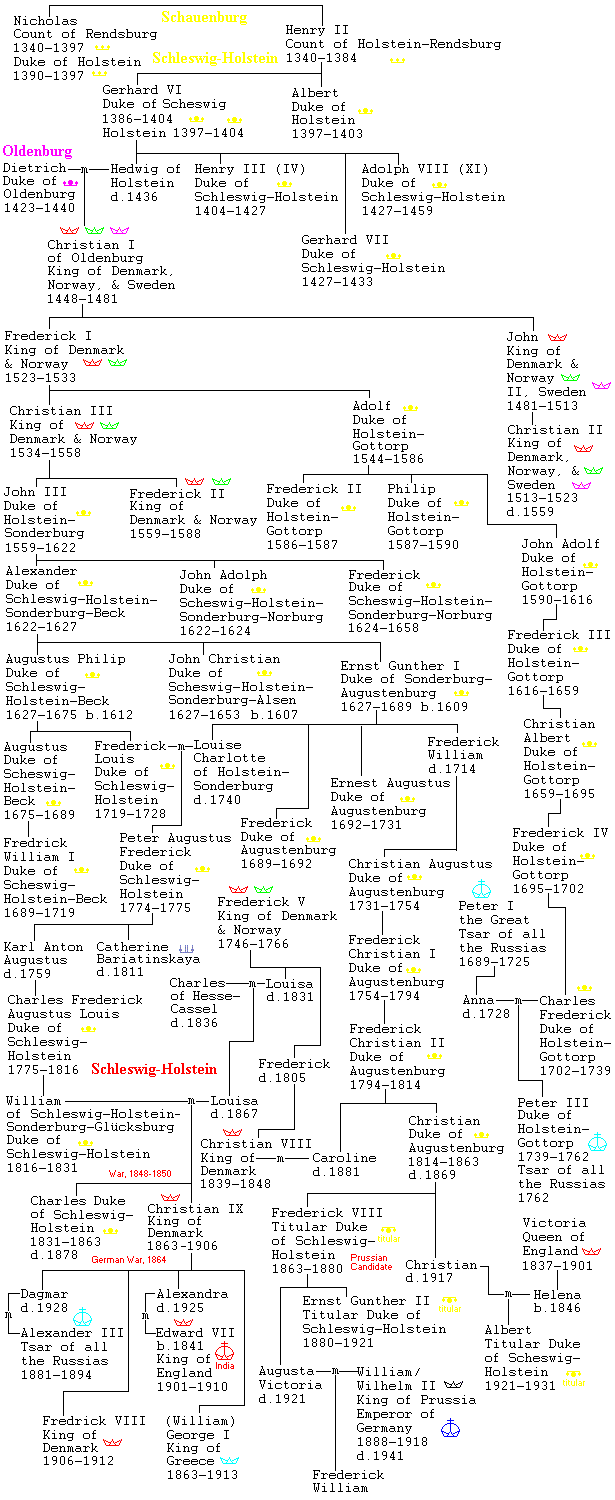
| Dukes of Pomerania |
|---|
Pomerania (German Pommern) was a historic territory on the shores of the Baltic Sea. It only enters history fully when the Duke Wartislaw I, of the House of Griffin (German Greifen, Polish Gryfici) becomes a vassal of Duke Boleslaw III (1102-1138) of Poland in 1121. This changed shortly, with the Duchy becoming the vassal instead of Duke Henry III the Lion (1142-1180, d.1195) of Saxony in 1164, and then directly of the Emperor in 1181, when Frederick Barbarosa deposed Henry. Pomerania thus becomes part of the Holy Roman Empire.
Considering that the Dukes have Slavic names, this is an interesting case (like Bohemia) of non-German people being integrated into what now looks like a German Empire. If one then looks for some kind of racial animus against the Dukes, it does not seem to occur. Instead, the Dukes intermarry with European royalty, and one of them, Eric I, even becomes the King of Norway, Sweden, and Denmark.
The Duchy comes to an end with a problem all too characteristic of Mediaeval government, the failure of the male line. Bogislaw XIV dies without sons in 1637 (after abdicating in 1634). As it happened, this was in the middle of the Thirty Years War (1618-1648), with the Duchy occupied for the duration by Sweden. In the Treaty of Westphalia (1648), Sweden received the Duchy West of the River Oder (Hither Pomerania), while Prussia received the rest of the Duchy, which extended well East of the Oder (Further Pomerania). Today, the Oder is itself the boundary between Germany and Poland, so Further Pomerania has again become part of Poland.
Sweden tried to retrieve the lost part of Hither Pomerania in the Pomeranian War, 1757-1762. This was part of the larger Seven Years War (1756-1763) against Prussia, and Sweden's main chance was from the help of Russia. Despite some successes, Frederick the Great of Prussia was ultimately able to hold off the Allies. This theater of the war abrupted collapsed when Russia withdrew from the conflict in 1762, and Sweden had no choice but to follow.
Meanwhile, Pomerania between Further Pomerania and the Vistula River had a separate history. It remained under Polish suzerainty as the Duchy of Pomerelia (German Pommerellen), sometimes subdivided, until taken over by the Teutonic Knights in 1309. In 1410, Poland and Lithuania inflicted a crushing defeat on the Knights at Tannenberg. By 1466, this had translated into considerable territorial loss, whereby Pomerelia and more became part of Poland. It was the Poles who began applying the name "Prussia" to these territories. When the Kingdom of Prussia partitioned Poland in 1772 and annexed the territories, Pomerelia and the rest became "West Prussia." Modern Poland has restored the name Pomerania.
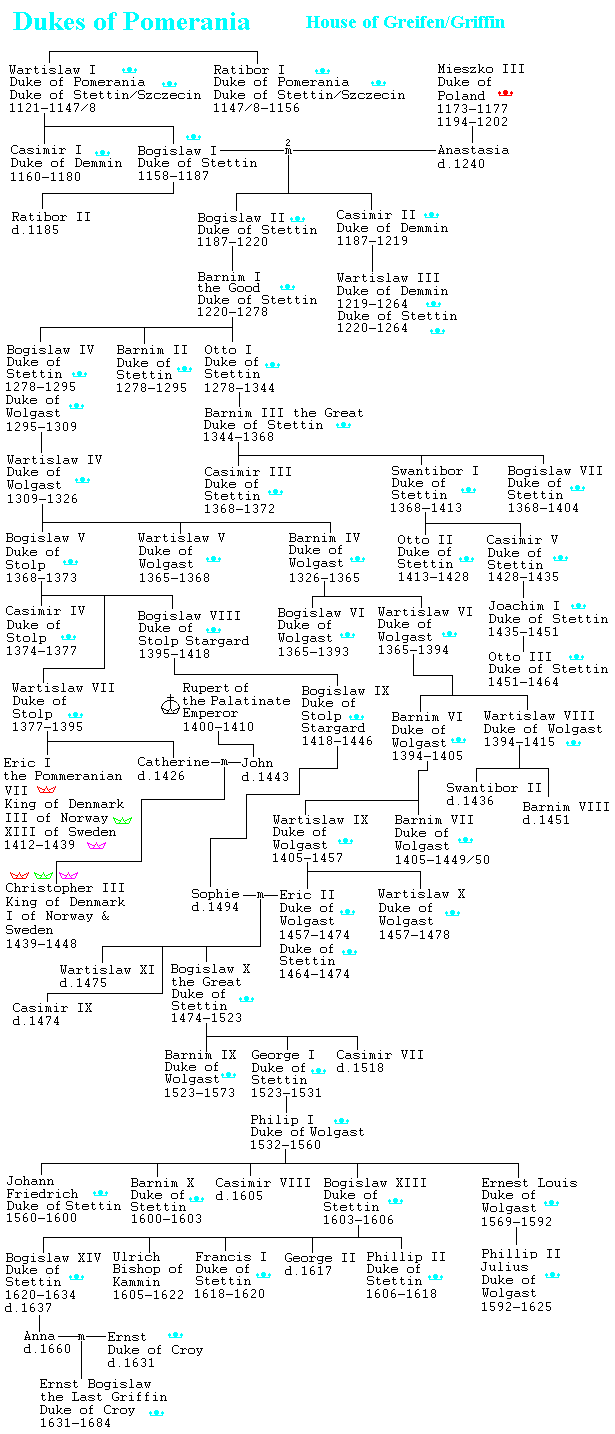
The genealogy here is based on Andreas Thiele's Erzählende genealogische Stammtafeln zur europäischen Geschichte, Volume I, Part 2, Deutsche Kaiser-, Königs-, Herzogs- und Grafenhäuser II [Third Edition, R. G. Fischer Verlag, 1997, pp.505-514]. In traditional fashion, the Duchy was for most of its history divided between different members of the family. It was hard to organize a succession list based on the genealogy, and so many of the dates are derived from the list of Dukes at Wikipedia -- though not all individuals in that list are accounted for in the genealogy.
